Paradox Security Systems MG6130 Wireless Console User Manual MAGELLAN EP06
Paradox Security Systems Wireless Console MAGELLAN EP06
Contents
- 1. User Manual 1
- 2. User Manual 2
- 3. User Manual 3
User Manual 2
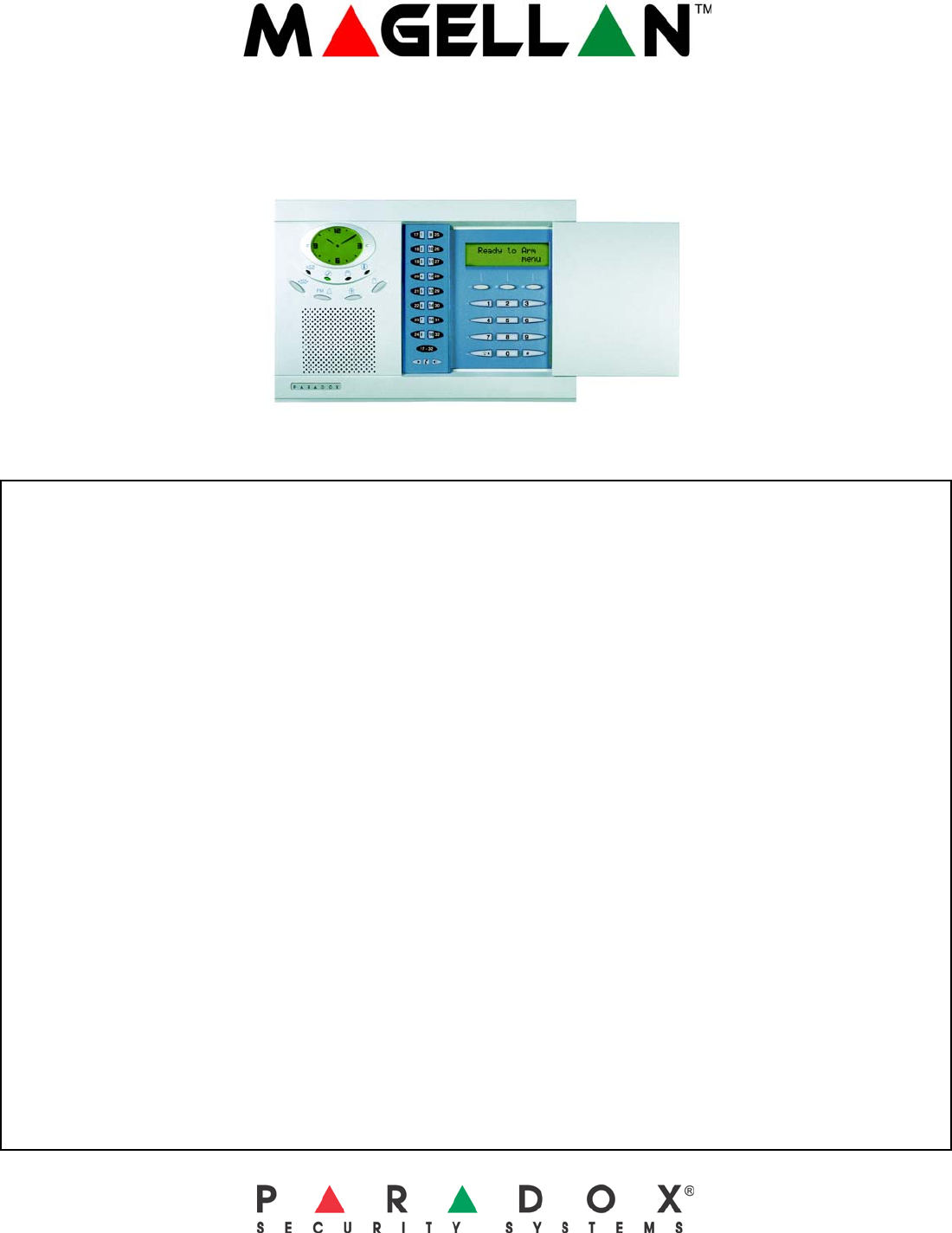
All-In-One Wireless Security System V2.0
Programming Guide
Model # MG-6130 / MG-6160
We hope this product performs to your complete satisfaction. Should you have any questions or comments, please visit
www.paradox.com and send us your comments.
Table of Contents
Things You Should Know..................................... 2
About This Programming Guide........................................... 2
Conventions......................................................................... 2
Installer Code (Default: 0000 / 000000)............................... 2
Maintenance Code (Default: 1111 / 111111)....................... 2
Master Code (Default: 1234 / 123456)................................. 2
Entering Programming Mode ............................... 2
Single Digit Data Entry Method............................................ 2
Feature Select Programming Method.................................. 3
Decimal and Hexadecimal Values ....................................... 3
Installer Quick Keys .............................................. 3
Zone Programming................................................ 4
Remote Control Button Programming................. 5
System Timers....................................................... 6
On-board Programmable Outputs (PGMs).......... 6
System Options ..................................................... 7
Communicator Settings ..................................... 10
Report Codes ....................................................... 11
System Settings................................................... 13
Wireless Transmitter Assignment...................... 13
Wireless Output Assignment .............................. 14
Wireless Keypad Assignment............................. 14
Wireless Repeater Assignment........................... 14
Wireless Programmable Output (PGM) Settings14
Wireless Supervision Options ............................ 14
Wireless Repeater Options.................................. 16
Appendix 1: PGM Event Table ............................ 18
Appendix 2: Specifications ................................. 20
Appendix 3: Connection Diagrams..................... 21
Power Connections........................................................... 21
Telephone Line Connections ............................................ 22
PGM Connections............................................................. 23
Hardwire Zone Connections.............................................. 24
Connecting the Radio Antenna (MG-6160 only) ............... 24
Connecting to a UIP-256................................................... 25
X10 Transmitter Connections (MG-6160 only).................. 25
Connecting Magellan to WinLoad ..................................... 26
Connecting a Paradox Memory Key (PMC-4)................... 26
Tabletop Mounting ............................................................ 27
Mounting Magellan on the Wall......................................... 27
Appendix 4: Ademco Contact ID Report Codes 28
Appendix 5: Automatic Report Code List .......... 30
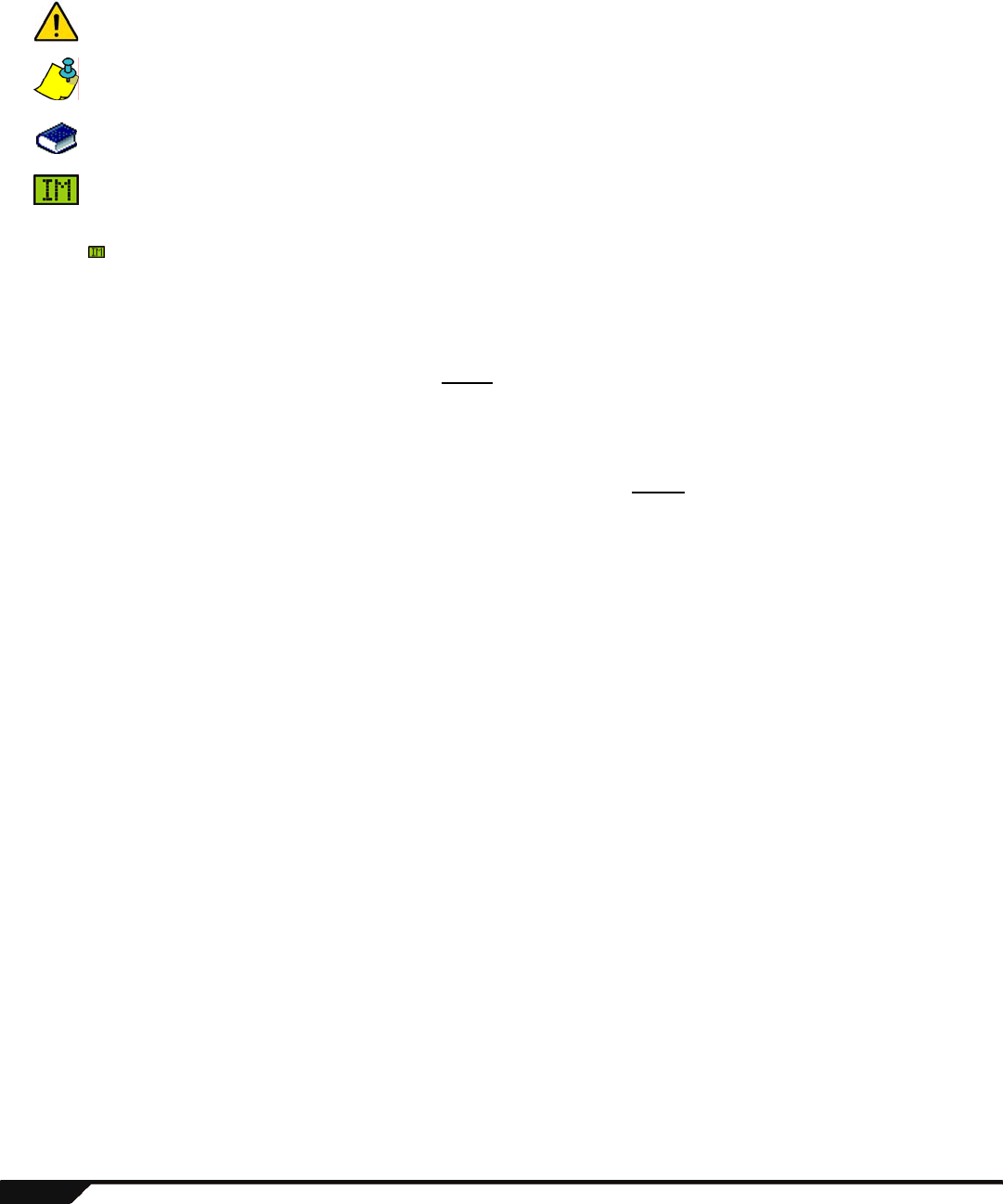
2Programming Guide
Things You Should Know
About This Programming Guide
This programming guide should be used in conjunction with the Magellan Reference & Installation Manual which can be downloaded
from our website at paradox.com. Use this guide to record the settings programmed for this console.
Conventions
Installer Code (Default: 0000 / 000000)
The Installer code is used to enter programming mode (see Entering Programming Mode on page 2), which allows you to program all the
features, options and commands of the Magellan console except user codes. The Installer code can be 4 or 6 digits in length (see section
[090] option [1] on page 7) where each digit can be any value from 0 to 9. See section [181] on page 13 to change the default code.
Maintenance Code (Default: 1111 / 111111)
The Maintenance code is similar to the Installer code. It can be used to enter programming mode (see Entering Programming Mode
on page 2), which allows you to program all the features, options and commands except for the Magellan console’s communication
settings (sections [108] to [112], sections [180] to [182]) as well as any user codes. The Maintenance code can be 4 or 6 digits in
length (see section [090] option [1] on page 7) where each digit can be any value from 0 to 9. See section [182] on page 13 to
change the default code (Installer only).
Master Code (Default: 1234 / 123456)
With the System Master code a user can use any arming method and can program user codes. The System Master code can be 4 or
6 digits in length (see section [090] option [1] on page 7), where each digit can be any digit from 0 to 9. The System Master code
cannot be changed by the Installer or Maintenance code, but it can be reset to default. See section [200] on page 13 to reset to default.
Entering Programming Mode
Use the built-in keypad to access Magellan’s installer programming mode. To access programming mode:
1. Press and hold the [0] key.
2. Enter your [INSTALLER CODE] or [MAINTENANCE CODE].
3. Enter the 3-digit [SECTION] you wish to program.
4. Enter the required [DATA].
5. Press the [*] key to clear data or to go back one step. Press the [#] key to save changes.
There are two methods that can be used to enter data when in programming mode: Single Digit Data Entry and Feature Select
Programming methods.
Single Digit Data Entry Method
After entering programming mode, some sections will require that you enter decimal values from 000 to 255. Other sections will
require that you enter hexadecimal values from 0 to F. The required data will be clearly indicated in this manual. When entering the
final digit in a section, Magellan will automatically save and advance to the next section. Refer to Figure 1 on page 3 to see the keys
and their equivalent decimal and/or hexadecimal value.
This symbol designates a warning or important information.
This symbol designates a suggestion or reminder.
This symbol designates a reference to another section, manual or guide.
This symbol designates a feature that can also be programmed in the Installer menu which can be accessed by pressing
[menu] and then entering your [INSTALLER CODE]. The icon will then be followed by the path or buttons that have to be
pressed in order to access the feature once in the Installer menu. For example:
= Once in the Installer menu, press the [4] key and then press the [6] key to access the desired feature.
Refer to the Installer Menu Overview on the back cover for more information on accessing and using the Installer menu.
J[4] J[6]
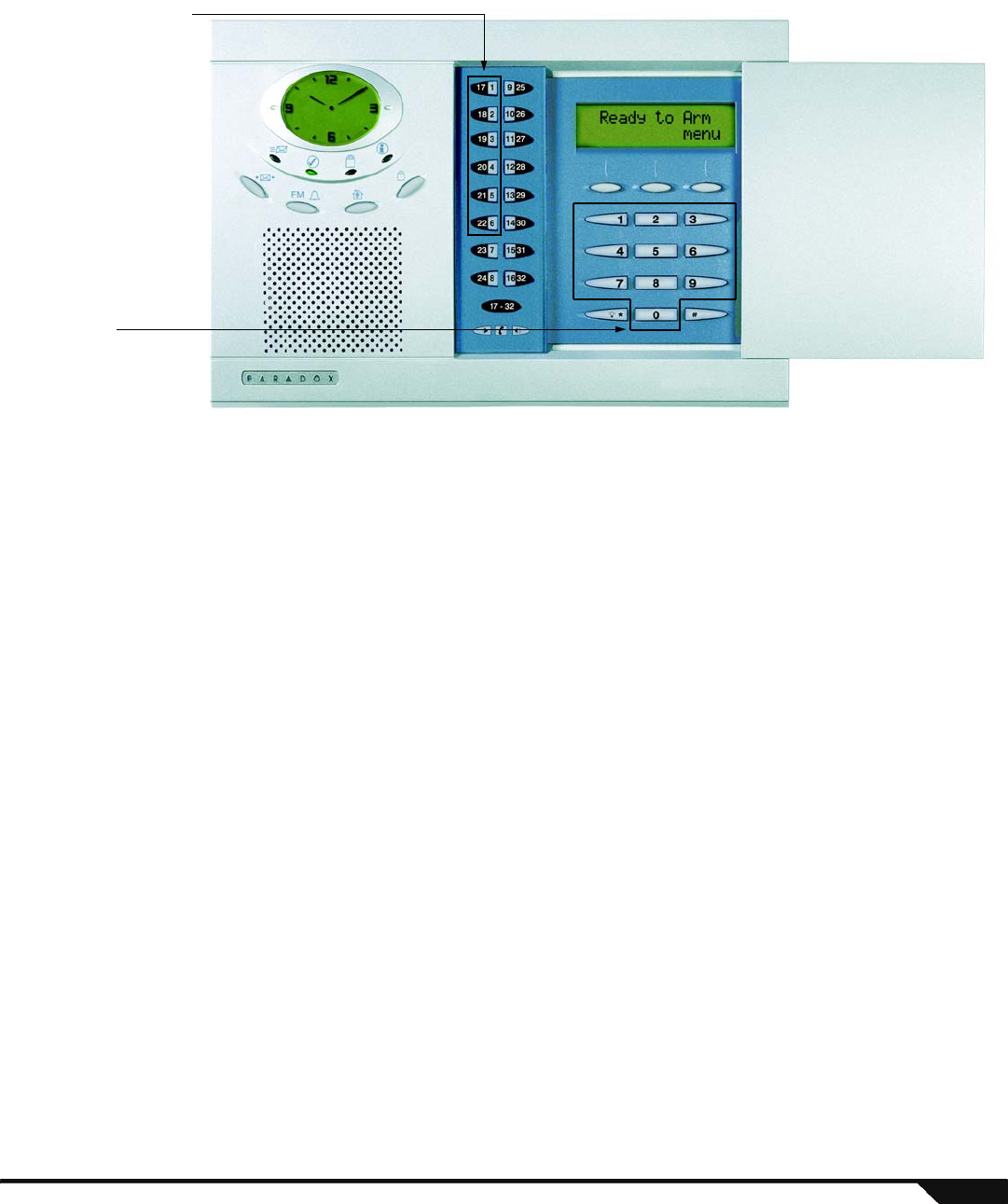
Magellan 3
Feature Select Programming Method
After entering certain sections, eight options will be displayed where each option from [1] to [8] represents a specific feature. Press
the key corresponding to the desired option and the option number will appear in the LCD screen. This means the option is ON.
Press the key again to remove the digit from the LCD screen (a * appears), thereby, turning OFF the option. Press the [*] key to set
all eight options to OFF. When the options are set, press the [#] key to save and advance to the next section.
Decimal and Hexadecimal Values
Figure 1: Decimal and Hexadecimal Values
Installer Quick Keys
To access the Installer Quick keys, press and hold the [0] key from the Main keypad, enter the [INSTALLER CODE] and then press from the
Center keypad:
Key [1] =Test Report: Send the “Test Report” report code programmed in section [171] (page 12) to the monitoring station.
Key [2] =Cancel Communication: Cancels all communication with the WinLoad software or with the monitoring station until the next
reportable event.
Key [3] =Answer WinLoad Software: Will force the console to answer an incoming call from the monitoring station that is using the
WinLoad software.
Key [4] =Call WinLoad Software: Will dial the PC telephone number programmed in section [115] (page 10) in order to initiate
communication with a computer using the WinLoad software.
Key [5] =Installer Test Mode: The installer test mode will allow you to perform walk tests where the siren will squawk to indicate opened
zones. Press the [5] key again to exit.
Decimal and
Hexadecimal
Values:
Keys [0] to [9] = 0
to 9
Hexadecimal only
values:
[1] = A
[2] = B
[3] = C
[4] = D
[5] = E
[6] = F
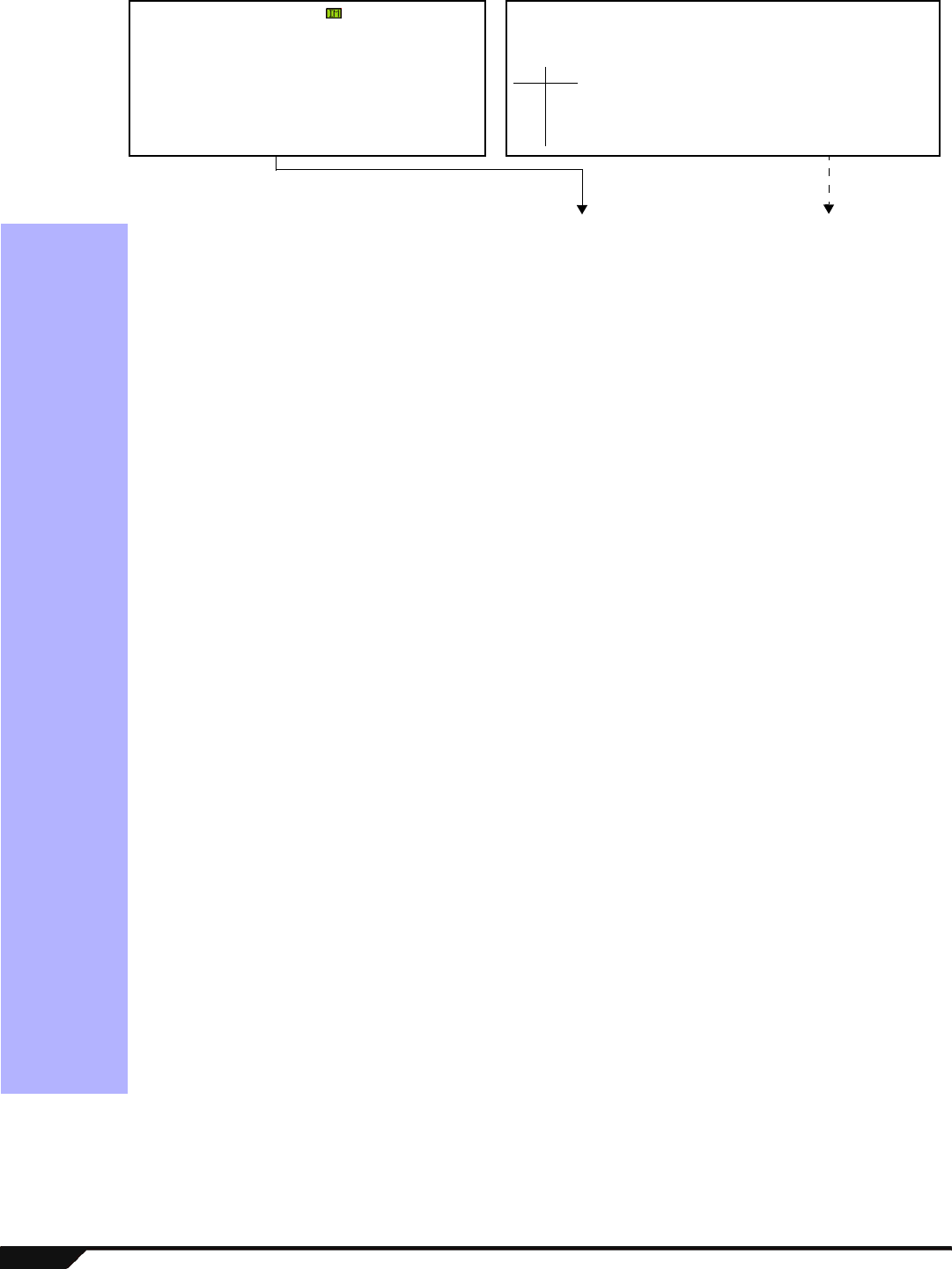
4Programming Guide
Zone Programming
Section Description Zone Definition Zone Options
[001] Zone 1:_____________________________ ______/______/______ 1 2 3 4 5 6 7 8
[002] Zone 2:_____________________________ ______/______/______ 1 2 3 4 5 6 7 8
[003] Zone 3:_____________________________ ______/______/______ 1 2 3 4 5 6 7 8
[004] Zone 4:_____________________________ ______/______/______ 1 2 3 4 5 6 7 8
[005] Zone 5:_____________________________ ______/______/______ 1 2 3 4 5 6 7 8
[006] Zone 6:_____________________________ ______/______/______ 1 2 3 4 5 6 7 8
[007] Zone 7:_____________________________ ______/______/______ 1 2 3 4 5 6 7 8
[008] Zone 8:_____________________________ ______/______/______ 1 2 3 4 5 6 7 8
[009] Zone 9:_____________________________ ______/______/______ 1 2 3 4 5 6 7 8
[010] Zone 10:____________________________ ______/______/______ 1 2 3 4 5 6 7 8
[011] Zone 11:____________________________ ______/______/______ 1 2 3 4 5 6 7 8
[012] Zone 12:____________________________ ______/______/______ 1 2 3 4 5 6 7 8
[013] Zone 13:____________________________ ______/______/______ 1 2 3 4 5 6 7 8
[014] Zone 14:____________________________ ______/______/______ 1 2 3 4 5 6 7 8
[015] Zone 15:____________________________ ______/______/______ 1 2 3 4 5 6 7 8
[016] Zone 16:____________________________ ______/______/______ 1 2 3 4 5 6 7 8
[017] Zone 17:____________________________ ______/______/______ 1 2 3 4 5 6 7 8
[018] Zone 18:____________________________ ______/______/______ 1 2 3 4 5 6 7 8
[019] Zone 19:____________________________ ______/______/______ 1 2 3 4 5 6 7 8
[020] Zone 20:____________________________ ______/______/______ 1 2 3 4 5 6 7 8
[021] Zone 21:____________________________ ______/______/______ 1 2 3 4 5 6 7 8
[022] Zone 22:____________________________ ______/______/______ 1 2 3 4 5 6 7 8
[023] Zone 23:____________________________ ______/______/______ 1 2 3 4 5 6 7 8
[024] Zone 24:____________________________ ______/______/______ 1 2 3 4 5 6 7 8
[025] Zone 25:____________________________ ______/______/______ 1 2 3 4 5 6 7 8
[026] Zone 26:____________________________ ______/______/______ 1 2 3 4 5 6 7 8
[027] Zone 27:____________________________ ______/______/______ 1 2 3 4 5 6 7 8
[028] Zone 28:____________________________ ______/______/______ 1 2 3 4 5 6 7 8
[029] Zone 29:____________________________ ______/______/______ 1 2 3 4 5 6 7 8
[030] Zone 30:____________________________ ______/______/______ 1 2 3 4 5 6 7 8
[031] Zone 31:____________________________ ______/______/______ 1 2 3 4 5 6 7 8
[032] Zone 32:____________________________ ______/______/______ 1 2 3 4 5 6 7 8
Zone Definitions ( )
000 = Zone Disabled (default)
001 = Entry Delay 1
002 = Entry Delay 2
003 = Follow Zone
004 = Follow / Stay Zone
005 = Instant Zone
006 = Instant / Stay Zone
007 = Instant Fire Zone
008 = Delayed Fire Zone
009 = 24Hr. Burglary Zone
010 = 24Hr. Hold-up Zone
011 = 24Hr. Buzzer Zone
012 = 24Hr. Gas Zone
013 = 24Hr. Heat Zone
014 = 24Hr. Water Zone
015 = 24Hr. Freeze Zone
J[4] J[6] Zone Options
[1] = Auto-zone Shutdown (default)
[2] = Bypassable Zone (default)
[3] = Future Use
[6] = Intellizone†
[7] = Delay alarm transmission
[8] = Force Zone (default)‡
† Intellizone is not for use in UL
installations.
‡ Force Arming is not permitted in UL
installations.
[4] [5] Zone Alarm Type
OFF OFF
Audible alarm (default)
OFF ON Pulsed alarm
ON OFF Silent alarm
ON ON Report only
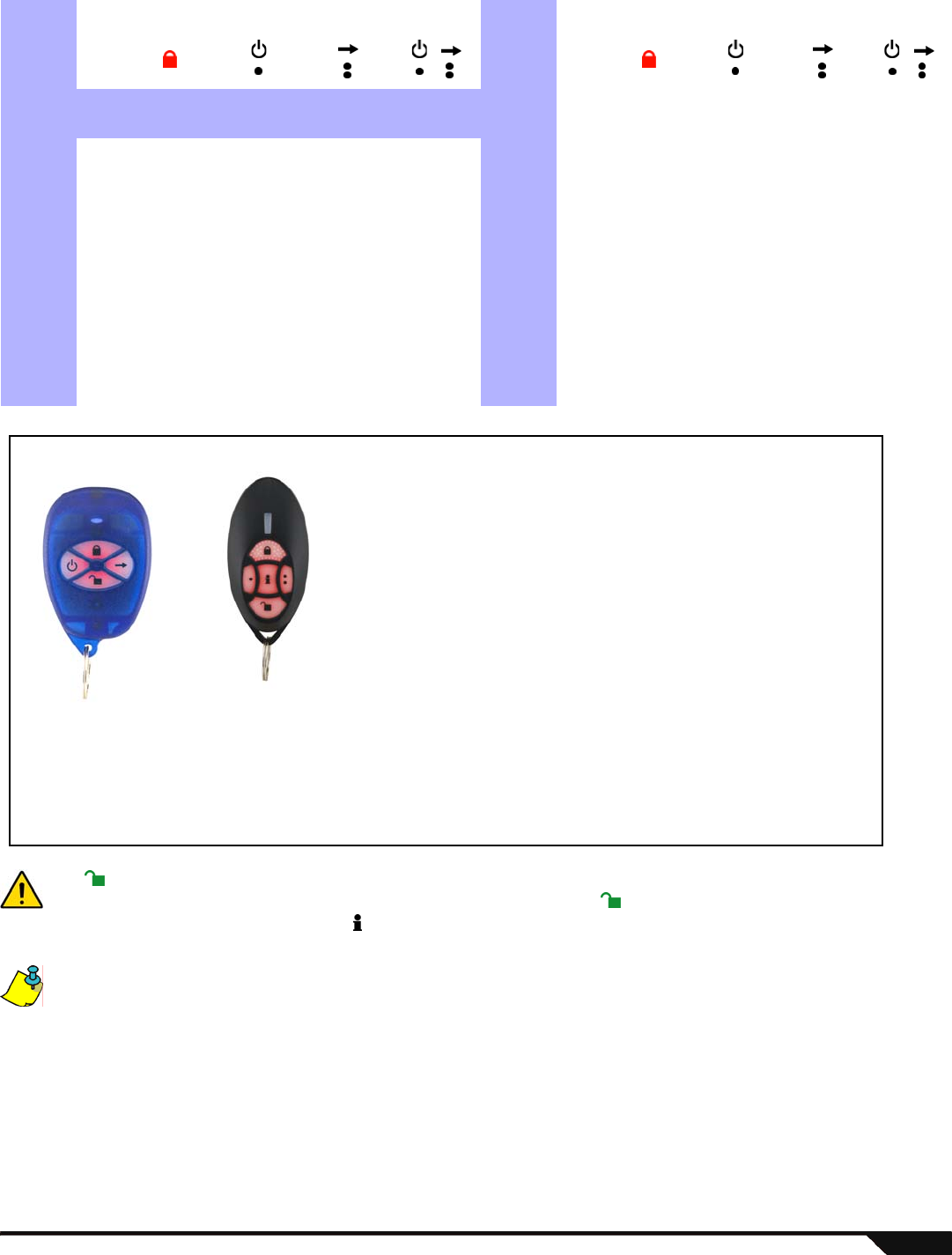
Magellan 5
Remote Control Button Programming
The button of the MG-REM1 and MG-REM2 remote controls has been permanently programmed to disarm the system. However, when
the system is disarmed and the Magellan console’s radio is on (MG-6160 only), the button can be used for volume control. The
button’s functionality cannot be altered. The button of the MG-REM2 remote control has been permanently programmed to request
feedback from the system. The button’s functionality cannot be altered.
When section [040] is accessed, the console will display the contents of section [041] and copy the saved value of that section to all remote
options: [041] to [56].
Section RC# Data (Default: 4DE0) Section RC# Data (Default: 4DE0)
[040]
Default 1-16 ______ ______ ______ ______
[041] 1 ______ ______ ______ ______ [049] 9 ______ ______ ______ ______
[042] 2 ______ ______ ______ ______ [050] 10 ______ ______ ______ ______
[043] 3 ______ ______ ______ ______ [051] 11 ______ ______ ______ ______
[044] 4 ______ ______ ______ ______ [052] 12 ______ ______ ______ ______
[045] 5 ______ ______ ______ ______ [053] 13 ______ ______ ______ ______
[046] 6 ______ ______ ______ ______ [054] 14 ______ ______ ______ ______
[047] 7 ______ ______ ______ ______ [055] 15 ______ ______ ______ ______
[048] 8 ______ ______ ______ ______ [056] 16 ______ ______ ______ ______
+
+
+
+
Button Options Table
0 - Button disabled
1 - Regular arming
2 - Stay arming
3 - Instant arming
4 - Force arming
5 - N/A
6 - N/A
7 - N/A
8 - Panic 1†
9 - Panic 2†
A* - Panic 3†
B* - PGM Activation (Event Group #7, see Appendix 1: PGM Event Table)
C* - PGM Activation (Event Group #8, see Appendix 1: PGM Event Table)
D* - Turn FM radio ON/OFF (MG-6160 only)
E* - FM radio memory scan (MG-6160 only)
F* - Non-medical alarm
* = Hex values A to F are keys [17/1] to [22/6] from Magellan’s Center
Keypad. Refer to Figure 1 on page 2.
† = The panic feature (section [091] options [1] to [3]) must be enabled.
MG-REM1 MG-REM2
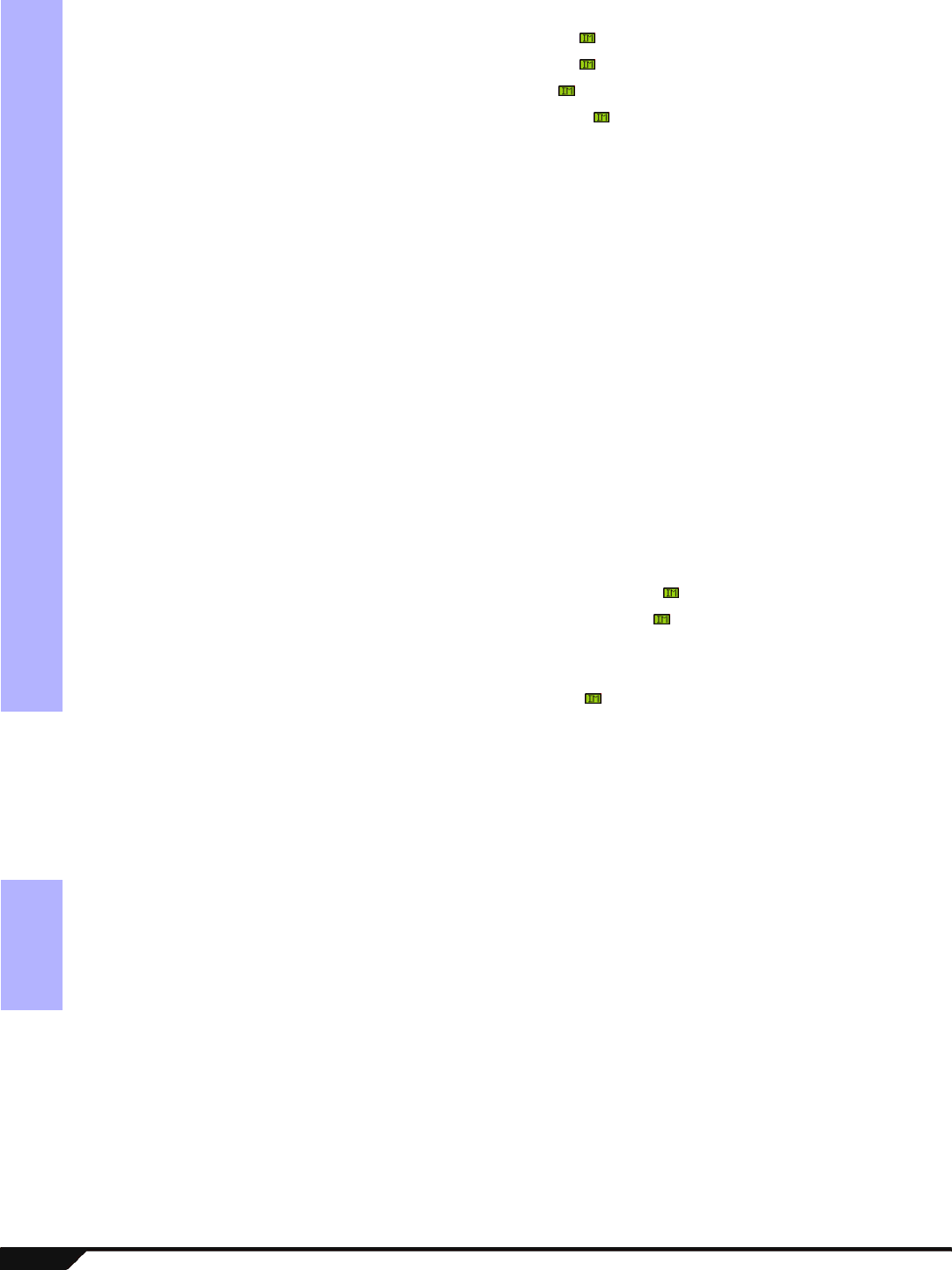
6Programming Guide
System Timers
** 000 = No tone; 001 = Beeping; 002 = Countdown; 003 = Tonality 1; 004 = Tonality 2; 005 = Tonality 3; 006 = Tonality 4;
007 = Radio tuner (MG-6160 only)
On-board Programmable Outputs (PGMs)
Refer to Appendix 1: PGM Event Table on page 18 for the PGM events that can be used to program Magellan’s PGM outputs.
Section Data (value from 000 to 255) Description Defaults
[060] ____/____/____ seconds Entry delay 1 ( ) † 045 secs.
[061] ____/____/____ seconds Entry delay 2 ( ) † 045 secs.
[062] ____/____/____ seconds Exit delay ( ) ‡ 060 secs.
[063] ____/____/____ minutes Bell cut-off time ( ) * 004 mins.
[064] ____/____/____ x 15 minutes No movement time Disabled
[065] ____/____/____ seconds (minimum 10 seconds) Intellizone delay 045 secs.
[066] ____/____/____ seconds Recent closing delay Disabled
[067] ____/____/____ times Auto-zone shutdown 005 times
[068] ____/____/____ seconds PGM1 timer Disabled
[069] ____/____/____ seconds PGM2 timer Disabled
[070] ____/____/____ minutes Power failure report delay 015 mins.
[071] ____/____/____ days Auto-test report Disabled
[072] ____/____/____ rings Number of rings 008 rings
[073] ____/____/____ seconds TLM fail timer 032 secs.
[074] ____/____/____ seconds Answering machine override delay 030 secs.
[075] ____/____/____ seconds Delay alarm transmission Disabled
[076] ____/____/____ seconds (maximum 130 seconds) Delay between dialing attempts V020 secs.
[077] ____/____/____ seconds Pager/voice delay 005 secs.
[078] ____/____/____ seconds Remote panic disarm lock delay 020 secs.
[079] ____/____/____ repetitions (maximum 10 repetitions) Voice reporting message repetitions 003 reps.
[080] ____/____/____ days Closing delinquency delay Disabled
[081] ____/____/____ (000 to 007**)Entry delay audio selection () 003
[082] ____/____/____ (000 to 007**)Exit delay audio selection () 002
[083] Future use Future use Future use
[084] ____/____:____/____ Hours Auto-test report time Disabled
[085] ____/____:____/____ Hours Auto-arm time () Disabled
Section Description Event Group # Sub-group # Default
[086] PGM1 Activation Event (____/____) (____/____) No event programmed
[087] PGM1 Deactivation Event (____/____) (____/____) No event programmed
[088] PGM2 Activation Event (____/____) (____/____) No event programmed
[089] PGM2 Deactivation Event (____/____) (____/____) No event programmed
J[4] J[4]
J[4] J[4]
J[4] J[4]
J[4] J[4]
J[4] J[4]
J[4] J[4]
J[8] J[3]
* For UL installations, the Bell cut-off time must be a minimum of 4 minutes; for
cUL installations, the Bell cut-off time must be a minimum of 5 minutes.
V For UL installations, the number of dialing attempts shall not exceed 10.
† For UL installations, the Entry delay must not exceed 45 seconds.
‡ For UL installations, the Exit delay must not exceed 60 seconds.

Magellan 7
System Options
[090] General Options Bold = Default setting
Option OFF ON
[1] Access code length 6 digits 4 digits
[2] Audible trouble warning (except AC power failures) Disabled Enabled
[3] Lock master code Disabled Enabled
[4] Use user code 16 as duress code Disabled Enabled
[5] Console tamper supervision Disabled Enabled
[6] Need code to bypass zones Disabled Enabled
[7] PGM1 normal state N.O. N.C.
[8] PGM2 normal state N.O. N.C.
[091] General Options Bold = Default setting
Option OFF ON
[1] Panic 1 (Emergency) Disabled Enabled
[2] Panic 2 (Auxiliary) Disabled Enabled
[3] Panic 3 (Fire) Disabled Enabled
[4] Panic 1: Silent or audible alarm Silent Audible
[5] Panic 2: Silent or audible alarm Silent Audible
[6] Panic 3: Silent or audible alarm Silent Audible
[7] PGM1 used as (MG-6160 only) Direct output X10 output 7
[8] PGM2 used as (MG-6160 only) Direct output X10 output 8
[092] Arming/Disarming Options Bold = Default setting
Option OFF ON
[1] Auto-arm on time ( ) †Disabled Enabled
[2] Auto-arm on no movement † Disabled Enabled
[3] Auto-arm in what arming mode † Regular Stay
[4] Switch to Stay arming if no entry delay is opened Disabled Enabled
[5] Regular arming switches to Force arming † Disabled Enabled
[6] Stay arming switches to Force arming † Disabled Enabled
[7] One-touch Regular/Force arming † Disabled Enabled
[8] One-touch Stay arming Disabled Enabled
† Force arming and Auto-arming are not for use in UL installations.
[093] Arming/Disarming Options Bold = Default setting
Option OFF ON
[1] Future use Future use Future use
[2] Future use Future use Future use
[3] Bell squawk when arming/disarming with remote control * Disabled Enabled
[4] No exit delay when arming with remote control Disabled Enabled
[5] Report system disarming Always After alarm only
[6] Exit delay termination Disabled Enabled
[7] Follow zones become Entry Delay 2 zones when Delay zone is
bypassed
Disabled Enabled
[8] FM tuner ON when system is armed ( ) (MG-6160 only) Disabled Enabled
* Bell Squawk on Arm must be enabled for UL installations.
J[8] J[2]
J[8] J[1]
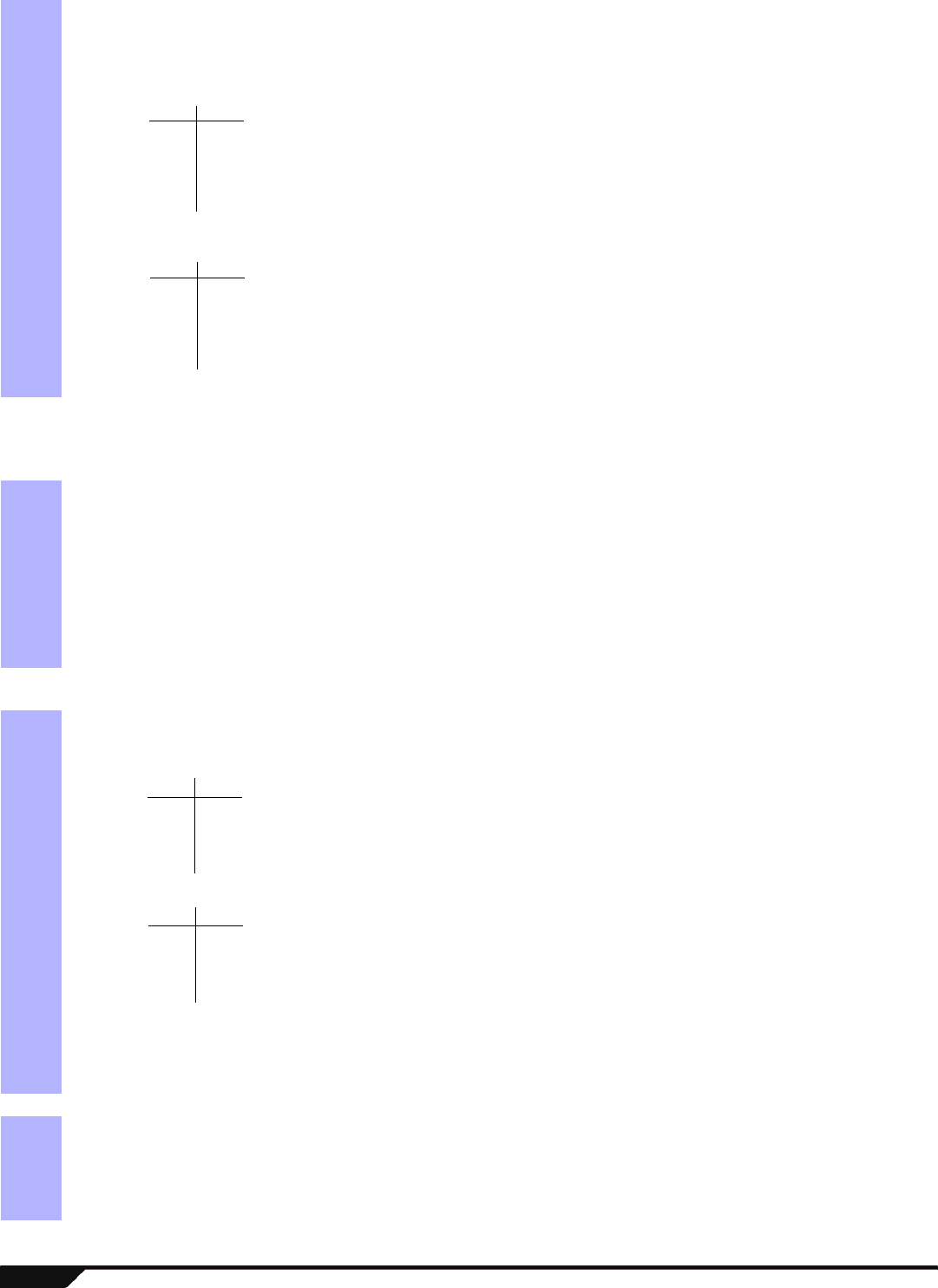
8Programming Guide
† For UL installations, Tamper recognition options must be enabled.
‡ For UL installations, Wireless supervision options must be enabled.
* For UL installations, if the zone is programmed as a wireless fire zone, supervision must be enabled and the check-in supervision time must be set at 80
minutes (section [096] option [7] on page 8).
* For UL installations, if either or both of the hardwired zones are enabled, then section [095] option [3] option must be enabled.
† This feature only applies to Magellan’s onboard zone inputs. Section [095] options [1] and [2] must be ON in order to use this feature.
* This option must be enabled for UL installations.
[094] Zone Options Bold = Default setting
Option OFF ON
[1] Stay delay zones Disabled Enabled
[2] Report zone restore On Bell cut-off On zone closure
[3] & [4] Tamper recognition options † See table
See table
See table
See table
[5] Generate tamper trouble if detected on bypassed zone No Yes
[6] & [7] Wireless transmitter supervision options ‡ See table
See table
See table
See table
[8] Generate supervision trouble if detected on bypassed zone No Yes
[095] Zone Options Bold = Default setting
Option OFF ON
[1] Zone 31 is hardwire zone 1 * Disabled Enabled
[2] Zone 32 is hardwire zone 2 * Disabled Enabled
[3] EOL (End-Of-Line) resistors † No EOL Use EOL resistors
[4] Stay arm siren delay Disabled Enabled
[5] Future use
[6] Live Display Mode for Wireless Keypad (MG32WK) Disabled Enabled
[7] & [8] Future use
[096] General Options Bold = Default setting
Option OFF ON
[1] & [2] Doorbell 1 tone options See table
See table
See table
See table
[3] & [4] Doorbell 2 tone options See table
See table
See table
See table
[5] Daylight savings time Disabled Enabled
[6] AC power failure warning * Disabled Enabled
[7] Check-in supervision time 24Hrs 80 minutes
[8] RF Jamming supervision * Disabled Enabled
[097] General Options Bold = Default setting
Option OFF ON
[1] Volume boost on entry/exit delay Disabled Enabled
[2] Volume boost in speakerphone mode Disabled Enabled
[3] to [8] Future use Future use Future use
[3] [4]
OFF OFF - Disabled
OFF ON - Trouble only
ON OFF - Disarmed: Trouble only
- Armed: Follow zone’s alarm type (page 4)
ON ON - Disarmed: Audible alarm
- Armed: Follow zone’s alarm type (page 4)
[6] [7]
OFF OFF - Disabled *
OFF ON - Trouble only
ON OFF - Disarmed: Trouble only
- Armed: Follow zone’s alarm type (page 4)
ON ON - Disarmed: Audible alarm
- Armed: Follow zone’s alarm type (page 4)
[1] [2]
OFF OFF - Tone 1
OFF ON - Tone 2
ON OFF - Tone 3
ON ON - Tone 4
[3] [4]
OFF OFF - Tone 1
OFF ON - Tone 2
ON OFF - Tone 3
ON ON - Tone 4

Magellan 9
* For UL installations, the telephone line monitoring must be enabled if off-premise transmission is used.
* For UL installations, only one telephone number is allowed.
* For UL installations, only one telephone number is allowed.
[098] Dialer Options Bold = Default setting
Option OFF ON
[1] & [2] Telephone line monitoring options * See table
See table
See table
See table
[3] Switch to pulse on 5th attempt Disabled Enabled
[4] Call back Disabled Enabled
[5] Alternate dialing Disabled Enabled
[6] Force dial Disabled Enabled
[7] DTMF dialing Disabled Enabled
[8] Pulse ratio 1:2 1:1.5
[099] Dialer Options 2 * Bold = Default setting
Option OFF ON
[1] Use monitoring station telephone number 2 as Regular Backup
[2] to [8] Future use Future use Future use
[100] Event Call Direction Options for: Bold = Default setting
Arming / Disarming Report Codes
Option OFF ON
[1] Call monitoring station telephone number 1 Disabled Enabled
[2] Call monitoring station telephone number 2 Disabled Enabled
[3] Call Pager telephone number Disabled Enabled
[4] Future use Future use Future use
Alarm / Alarm Restore Report Codes
[5] Call monitoring station telephone number 1 Disabled Enabled
[6] Call monitoring station telephone number 2 Disabled Enabled
[7] Call Pager telephone number Disabled Enabled
[8] Future use Future use Future use
[101] Event Call Direction Options for: Bold = Default setting
Tamper / Tamper Restore Report Codes
Option OFF ON
[1] Call monitoring station telephone number 1 Disabled Enabled
[2] Call monitoring station telephone number 2 Disabled Enabled
[3] Call Pager telephone number Disabled Enabled
[4] Future use Future use Future use
Trouble / Trouble Restore Report Codes
[5] Call monitoring station telephone number 1 Disabled Enabled
[6] Call monitoring station telephone number 2 Disabled Enabled
[7] Call Pager telephone number Disabled Enabled
[8] Future use Future use Future use
[102] Event Call Direction Options for: Bold = Default setting
Special Report Codes *
Option OFF ON
[1] Call monitoring station telephone number 1 Disabled Enabled
[2] Call monitoring station telephone number 2 Disabled Enabled
[3] Call Pager telephone number Disabled Enabled
[4] to [8] Future use Future use Future use
[1] [2]
OFF OFF - TLM disabled
OFF ON - Generate a trouble
ON OFF - Generate audible alarm if armed
ON ON - Silent alarms become audible
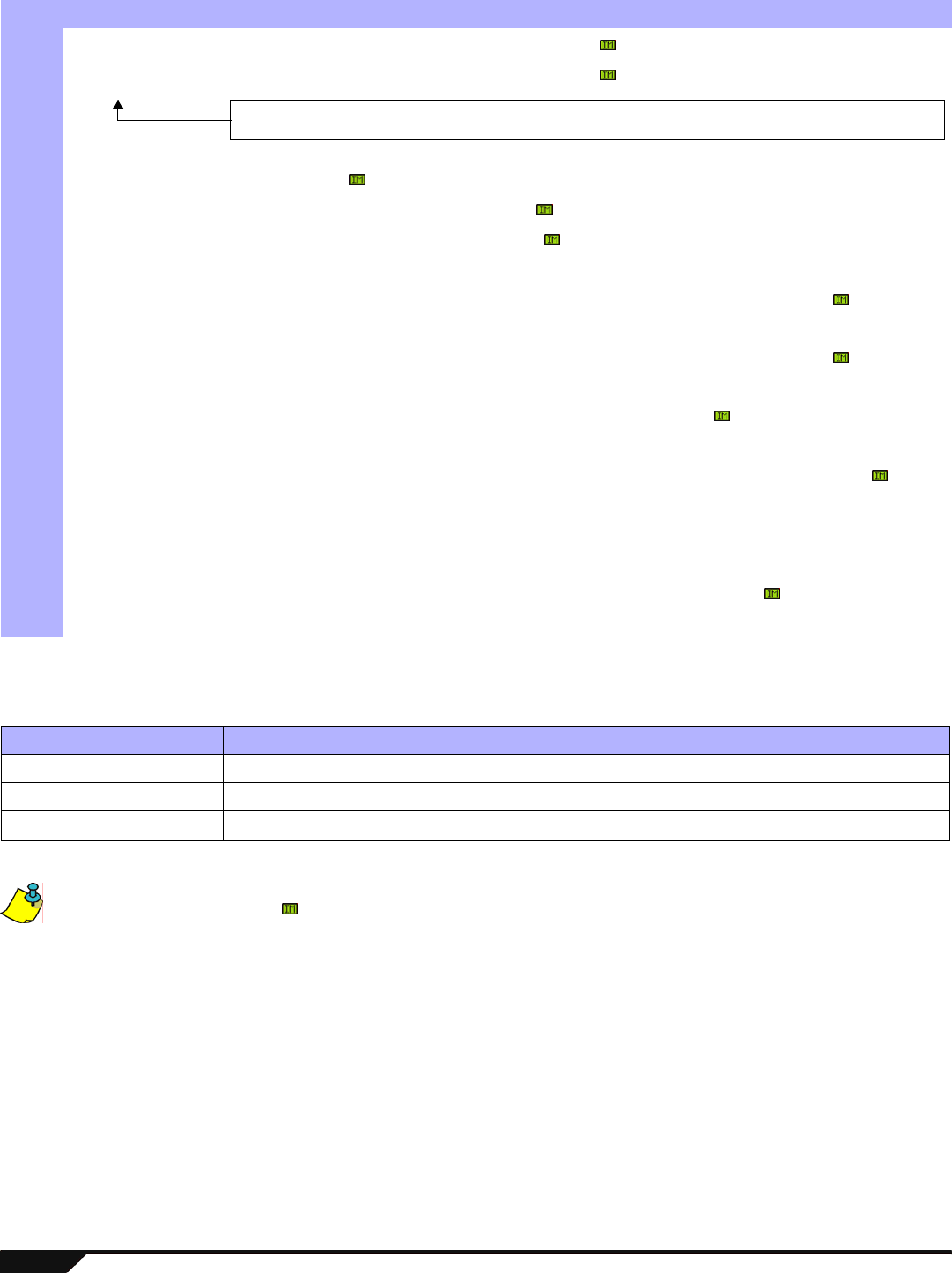
10 Programming Guide
Communicator Settings
* Using Magellan’s speakerphone feature (MG-6160 only), the Service telephone number allows the user to directly call the installer or maintenance staff if any problems arise.
† If you are using any report format other than SIA in sections [105] and [106] and you would like to transmit an “A”, press [0] on the main keypad; if you would like to enter a
space (non-reportable digit), press the [1] key on the center keypad.
Table 1: Special Keys for Telephone Numbers
There are five personal telephone numbers used for voice reporting. These telephone numbers are programmed through the
console’s communicator menu. ()
Section Data Description
[105] ____/____/____ Report format for monitoring station telephone number 1 ( )
[106] ____/____/____ Report format for monitoring station telephone number 2 ( )
[107] ____/____/____/____ Account number ( ) †
[108] ____/____/____/____ Panel identifier (for use with WinLoad software) ( )
[109] ____/____/____/____ Panel password (for use with WinLoad software) ( )
[110] Reserved for future use
[111] Monitoring station telephone number 1 (32 digits maximum; if less than 32, press [ok] to accept) ()
___/___/___/___/___/___/___/___/___/___/___/___/___/___/___/___/___/___/___/___/___/___/___/___/___/___/___/___/___/___/___/___
[112] Monitoring station telephone number 2 (32 digits maximum; if less than 32, press [ok] to accept) ()
___/___/___/___/___/___/___/___/___/___/___/___/___/___/___/___/___/___/___/___/___/___/___/___/___/___/___/___/___/___/___/___
[113] Pager Telephone # (32 digits maximum; if less than 32, press [ok] to accept) ()
___/___/___/___/___/___/___/___/___/___/___/___/___/___/___/___/___/___/___/___/___/___/___/___/___/___/___/___/___/___/___/___
[114] Numeric message sent with Pager Reporting (32 digits maximum; if less than 32, press [ok] to accept) ()
___/___/___/___/___/___/___/___/___/___/___/___/___/___/___/___/___/___/___/___/___/___/___/___/___/___/___/___/___/___/___/___
[115] PC telephone number for WinLoad (32 digits maximum; if less than 32, press [ok] to accept)
___/___/___/___/___/___/___/___/___/___/___/___/___/___/___/___/___/___/___/___/___/___/___/___/___/___/___/___/___/___/___/___
[116] Service telephone number* (32 digits maximum; if less than 32, press [ok] to accept) () (MG-6160 only)
___/___/___/___/___/___/___/___/___/___/___/___/___/___/___/___/___/___/___/___/___/___/___/___/___/___/___/___/___/___/___/___
Keys to press Action or Value
[*] *
[#] #
Center [ACTION] (pause) key Add a 4-second pause to the telephone number. Press the key and a “P” will be inserted into the telephone number
J[4] J[3]
J[4] J[3]
001 = Ademco slow (1400Hz 10BPS) 002 = Silent Knight (1400Hz 20BPS) 003 = SESCOA (2300Hz 20BPS)
004 = Ademco Contact ID (default) 005 = SIA FSK 006 = ADEMCO Express (DTMF 4+2)
J[4] J[3]
J[4] J[9]
J[4] J[9]
J[4] J[3]
J[4] J[3]
J[4] J[3]
J[4] J[3]
J[4] J[3]
J[4] J[3]

Magellan 11
Report Codes Default = FF
Default = FF
Arming Report Codes Special Arming Report Codes Disarming Report Codes Special Disarming Report Codes
Section Data Section Data Section Data Section Data
[120] ____/____ User Code 1 [124] ____/____ Auto-arming [126] ____/____ User Code 1 [130] ____/____ End auto-arm
____/____ User Code 2 ____/____ Late to close ____/____ User Code 2 ____/____ Disarm via PC
____/____ User Code 3 ____/____ No movement ____/____ User Code 3 ____/____ Future use
____/____ User Code 4 ____/____ Partial arming ____/____ User Code 4 ____/____ Future use
[121] ____/____ User Code 5 [125] ____/____ Quick-arming [127] ____/____ User Code 5
____/____ User Code 6 ____/____ Arming via PC ____/____ User Code 6
____/____ User Code 7 ____/____ Future use ____/____ User Code 7
____/____ User Code 8 ____/____ Future use ____/____ User Code 8
[122] ____/____ User Code 9 [128] ____/____ User Code 9
____/____ User Code 10 ____/____ User Code 10
____/____ User Code 11 ____/____ User Code 11
____/____ User Code 12 ____/____ User Code 12
[123] ____/____ User Code 13 [129] ____/____ User Code 13
____/____ User Code 14 ____/____ User Code 14
____/____ User Code 15 ____/____ User Code 15
____/____ User Code 16 ____/____ User Code 16
Alarm Report Codes Alarm Report Codes Alarm Restore Report Codes Alarm Restore Report Codes
Section Data Section Data Section Data Sec-
tion Data
[131] ____/____ Zone 1 [135] ____/____ Zone 17 [139] ____/____ Zone 1 [143] ____/____ Zone 17
____/____ Zone 2 ____/____ Zone 18 ____/____ Zone 2 ____/____ Zone 18
____/____ Zone 3 ____/____ Zone 19 ____/____ Zone 3 ____/____ Zone 19
____/____ Zone 4 ____/____ Zone 20 ____/____ Zone 4 ____/____ Zone 20
[132] ____/____ Zone 5 [136] ____/____ Zone 21 [140] ____/____ Zone 5 [144] ____/____ Zone 21
____/____ Zone 6 ____/____ Zone 22 ____/____ Zone 6 ____/____ Zone 22
____/____ Zone 7 ____/____ Zone 23 ____/____ Zone 7 ____/____ Zone 23
____/____ Zone 8 ____/____ Zone 24 ____/____ Zone 8 ____/____ Zone 24
[133] ____/____ Zone 9 [137] ____/____ Zone 25 [141] ____/____ Zone 9 [145] ____/____ Zone 25
____/____ Zone 10 ____/____ Zone 26 ____/____ Zone 10 ____/____ Zone 26
____/____ Zone 11 ____/____ Zone 27 ____/____ Zone 11 ____/____ Zone 27
____/____ Zone 12 ____/____ Zone 28 ____/____ Zone 12 ____/____ Zone 28
[134] ____/____ Zone 13 [138] ____/____ Zone 29 [142] ____/____ Zone 13 [146] ____/____ Zone 29
____/____ Zone 14 ____/____ Zone 30 ____/____ Zone 14 ____/____ Zone 30
____/____ Zone 15 ____/____ Zone 31 ____/____ Zone 15 ____/____ Zone 31
____/____ Zone 16 ____/____ Zone 32 ____/____ Zone 16 ____/____ Zone 32

12 Programming Guide
Default = FF
Default = FF
Special Alarm Report Codes Tamper Report Codes Tamper Report Codes Tamper Restore Report Codes
Section Data Section Data Section Data Section Data
[147] ____/____ Emer. panic [149] ____/____ Zone 1 [153] ____/____ Zone 17 [157] ____/____ Zone 1
____/____ Aux. panic ____/____ Zone 2 ____/____ Zone 18 ____/____ Zone 2
____/____ Fire panic ____/____ Zone 3 ____/____ Zone 19 ____/____ Zone 3
____/____
Recent closing
____/____ Zone 4 ____/____ Zone 20 ____/____ Zone 4
[148] ____/____ Zone shutdown [150] ____/____ Zone 5 [154] ____/____ Zone 21 [158] ____/____ Zone 5
____/____ Duress ____/____ Zone 6 ____/____ Zone 22 ____/____ Zone 6
____/____ Paramedical ____/____ Zone 7 ____/____ Zone 23 ____/____ Zone 7
____/____ Future use ____/____ Zone 8 ____/____ Zone 24 ____/____ Zone 8
[151] ____/____ Zone 9 [155] ____/____ Zone 25 [159] ____/____ Zone 9
____/____ Zone 10 ____/____ Zone 26 ____/____ Zone 10
____/____ Zone 11 ____/____ Zone 27 ____/____ Zone 11
____/____ Zone 12 ____/____ Zone 28 ____/____ Zone 12
[152] ____/____ Zone 13 [156] ____/____ Zone 29 [160] ____/____ Zone 13
____/____ Zone 14 ____/____ Zone 30 ____/____ Zone 14
____/____ Zone 15 ____/____ Zone 31 ____/____ Zone 15
____/____ Zone 16 ____/____ Zone 32 ____/____ Zone 16
Tamper Restore Report Codes System Trouble Report Codes System Troubles Restore Report
Codes Special Report Codes
Section Data Section Data Section Data Section Data
[161] ____/____ Zone 17 [165] ____/____ Future use [168] ____/____ Future use [171] ____/____ Cold start
____/____ Zone 18 ____/____ AC failure ____/____ AC failure ____/____ Test report
____/____ Zone 19 ____/____ Battery failure ____/____ Battery failure ____/____ Future use
____/____ Zone 20 ____/____ Timer loss ____/____ Timer prog. ____/____ WinLoad
logout
[162] ____/____ Zone 21 [166] ____/____ Unit tamper [169] ____/____ Unit tamp. rest. [172] ____/____ Installer logon
____/____ Zone 22 ____/____ Fail to comm. ____/____ Future use ____/____
Installer logout
____/____ Zone 23 ____/____ TX low battery ____/____ TX low battery ____/____ Delinquency
____/____ Zone 24 ____/____
TX superv.
loss ____/____
TX superv.
rest. ____/____ Future use
[163] ____/____ Zone 25 [167] ____/____ RF jamming
supervision [167] ____/____ RF jamming
supervision
____/____ Zone 26 ____/____ Future use ____/____ Future use
____/____ Zone 27 ____/____ Future use ____/____ Future use
____/____ Zone 28 ____/____ Future use ____/____ Future use
[164] ____/____ Zone 29
____/____ Zone 30
____/____ Zone 31
____/____ Zone 32

Magellan 13
Default = FF
System Settings
Wireless Transmitter Assignment
Wireless transmitter assignment may be done through the console’s menu (). Alternatively, assign the transmitter by entering its
serial number in the corresponding section:
Wireless Module Trouble Report
Codes Wireless Module Trouble Restore Report
Codes
[173] ____/____ PGM Supervision
Loss [175] ____/____ PGM Supervision
Restored
____/____ PGM Tamper ____/____ PGM Tamper
Restored
____/____ Keypad
Supervision
Loss
____/____ Keypad Supervision
Restored
____/____ Keypad Battery
Trouble
____/____ Keypad Battery
Trouble Restored
[174] ____/____ Keypad AC
Failure [176] ____/____ Keypad AC Restored
____/____ Repeater
Supervision Lost
____/____ Repeater Supervision
Restored
____/____ Repeater Battery
Trouble
____/____ Repeater Battery
Trouble Restored
____/____ Repeater AC
Failure
____/____ Repeater AC
Restored
Section Data Description Default
[180] ____/____/____ Installer code lock
(Enter 147 to lock code, 000 to unlock code)
000
[181] ____/____/____/____/____/____ Installer code () 000000
[182] ____/____/____/____/____/____ Maintenance code () 111111
[199] Reset all programmable sections to factory default values
[200] Reset Master code to default (123456)
Section Serial Number Section Serial Number
[201] Zone 1: ____/____/____/____/____/____ [219] Zone 19: ____/____/____/____/____/____
[202] Zone 2: ____/____/____/____/____/____ [220] Zone 20: ____/____/____/____/____/____
[203] Zone 3: ____/____/____/____/____/____ [221] Zone 21: ____/____/____/____/____/____
[204] Zone 4: ____/____/____/____/____/____ [222] Zone 22: ____/____/____/____/____/____
[205] Zone 5: ____/____/____/____/____/____ [223] Zone 23: ____/____/____/____/____/____
[206] Zone 6: ____/____/____/____/____/____ [224] Zone 24: ____/____/____/____/____/____
[207] Zone 7: ____/____/____/____/____/____ [225] Zone 25: ____/____/____/____/____/____
[208] Zone 8: ____/____/____/____/____/____ [226] Zone 26: ____/____/____/____/____/____
[209] Zone 9: ____/____/____/____/____/____ [227] Zone 27: ____/____/____/____/____/____
[210] Zone 10: ____/____/____/____/____/____ [228] Zone 28: ____/____/____/____/____/____
[211] Zone 11: ____/____/____/____/____/____ [229] Zone 29: ____/____/____/____/____/____
[212] Zone 12: ____/____/____/____/____/____ [230] Zone 30: ____/____/____/____/____/____
[213] Zone 13: ____/____/____/____/____/____ [231] Zone 31: ____/____/____/____/____/____
[214] Zone 14: ____/____/____/____/____/____ [232] Zone 32: ____/____/____/____/____/____
[215] Zone 15: ____/____/____/____/____/____ [233] Wireless Doorbell 1: ____/____/____/____/____/____
[216] Zone 16: ____/____/____/____/____/____ [234] Wireless Doorbell 2: ____/____/____/____/____/____
[217] Zone 17: ____/____/____/____/____/____
[218] Zone 18: ____/____/____/____/____/____
J[4] J[8]
J[4] J[8]
J[4] J[6]
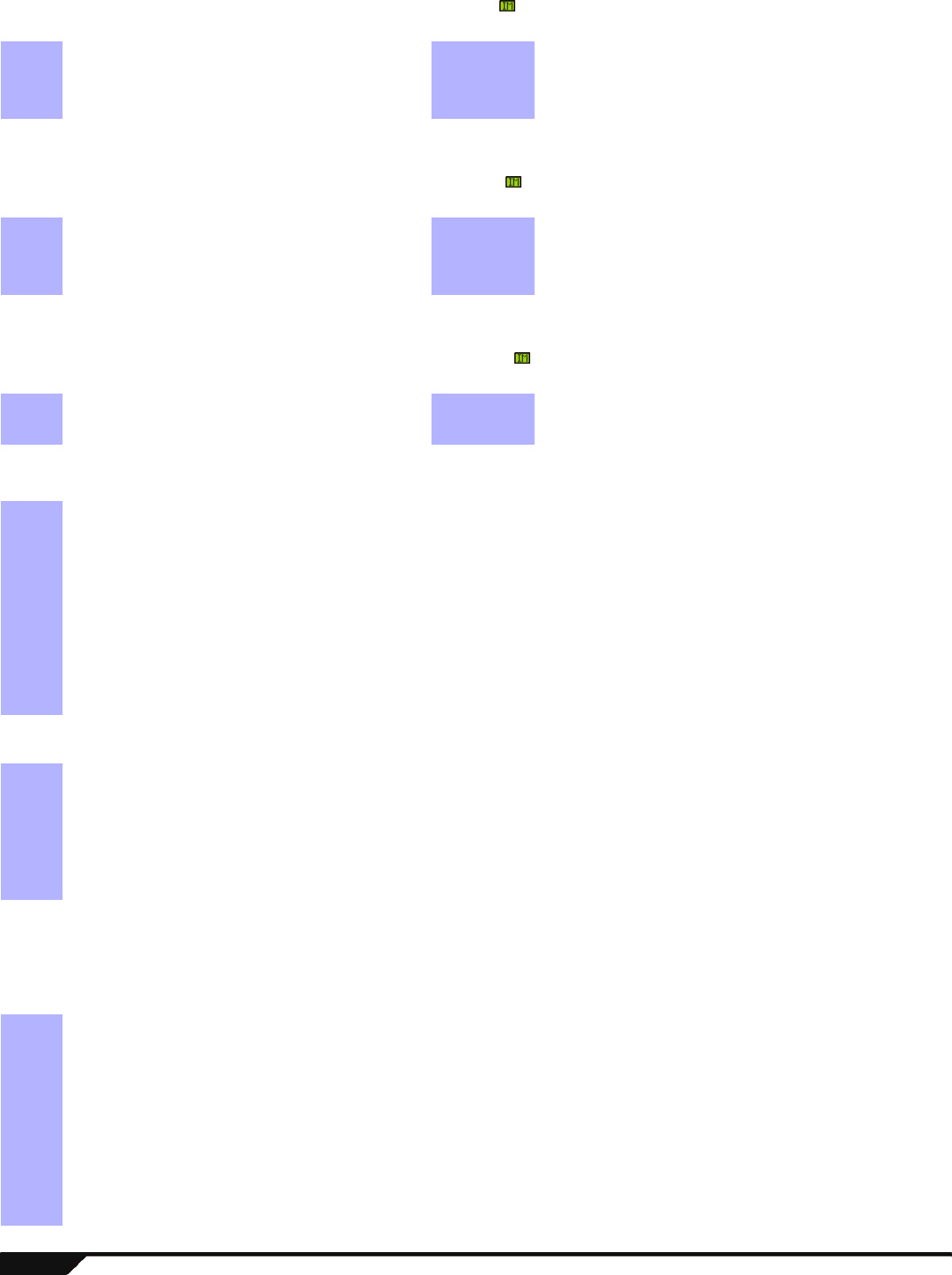
14 Programming Guide
Wireless Output Assignment
Wireless output assignment may be done through the console’s menu (). Alternatively, assign the PGM by entering its serial
number in the corresponding section:
Wireless Keypad Assignment
Wireless keypad assignment may be done through the console’s menu (). Alternatively, assign the keypad by entering its serial
number in the corresponding section:
Wireless Repeater Assignment
Wireless repeater assignment may be done through the console’s menu (). Alternatively, assign the repeater by entering its
serial number in the corresponding section:
Wireless Programmable Output (PGM) Settings
Refer to Appendix 1: PGM Event Table on page 18 for the PGM events that can be used to program Magellan’s PGM outputs.
† 000 = No delay; 001 = 1s delay; 002 = 5s delay; 003 = 15s delay; 004 = 30s delay; 005 = 1min delay; 006 = 5min delay;
007 = 15min delay; 008 = 30min delay.
Wireless Supervision Options
Section Serial Number Section Serial Number
[235] PGM1: ____/____/____/____/____/____ [237] PGM3: ____/____/____/____/____/____
[236] PGM2: ____/____/____/____/____/____ [238] PGM4: ____/____/____/____/____/____
Section Serial Number Section Serial Number
[243] Keypad 1: ____/____/____/____/____/____ [245] Keypad 3: ____/____/____/____/____/____
[244] Keypad 2: ____/____/____/____/____/____ [246] Keypad 4: ____/____/____/____/____/____
Section Serial Number Section Serial Number
[247] Repeater 1: ____/____/____/____/____/____ [248] Repeater 2: ____/____/____/____/____/____
Section Description Event Group # Sub-group # Default
[260] Wireless PGM1 Activation Event (____/____) (____/____) No event programmed
[261] Wireless PGM1 Deactivation Event (____/____) (____/____) No event programmed
[262] Wireless PGM2 Activation Event (____/____) (____/____) No event programmed
[263] Wireless PGM2 Deactivation Event (____/____) (____/____) No event programmed
[264] Wireless PGM3 Activation Event (____/____) (____/____) No event programmed
[265] Wireless PGM3 Deactivation Event (____/____) (____/____) No event programmed
[266] Wireless PGM4 Activation Event (____/____) (____/____) No event programmed
[267] Wireless PGM4 Deactivation Event (____/____) (____/____) No event programmed
Section Data Description Default
[280] ____/____/____ (000 to 008) † Wireless PGM1 timer 000
[281] ____/____/____ (000 to 008) † Wireless PGM2 timer 000
[282] ____/____/____ (000 to 008) † Wireless PGM3 timer 000
[283] ____/____/____ (000 to 008) † Wireless PGM4 timer 000
[290] Wireless Transmitter Supervision Zone Options * Bold = Default setting
Option OFF ON
[1] Zone 1 supervision Disabled Enabled
[2] Zone 2 supervision Disabled Enabled
[3] Zone 3 supervision Disabled Enabled
[4] Zone 4 supervision Disabled Enabled
[5] Zone 5 supervision Disabled Enabled
[6] Zone 6 supervision Disabled Enabled
[7] Zone 7 supervision Disabled Enabled
[8] Zone 8 supervision Disabled Enabled
J[4] J[7]
J[4] J[8]
J[4] J[9]
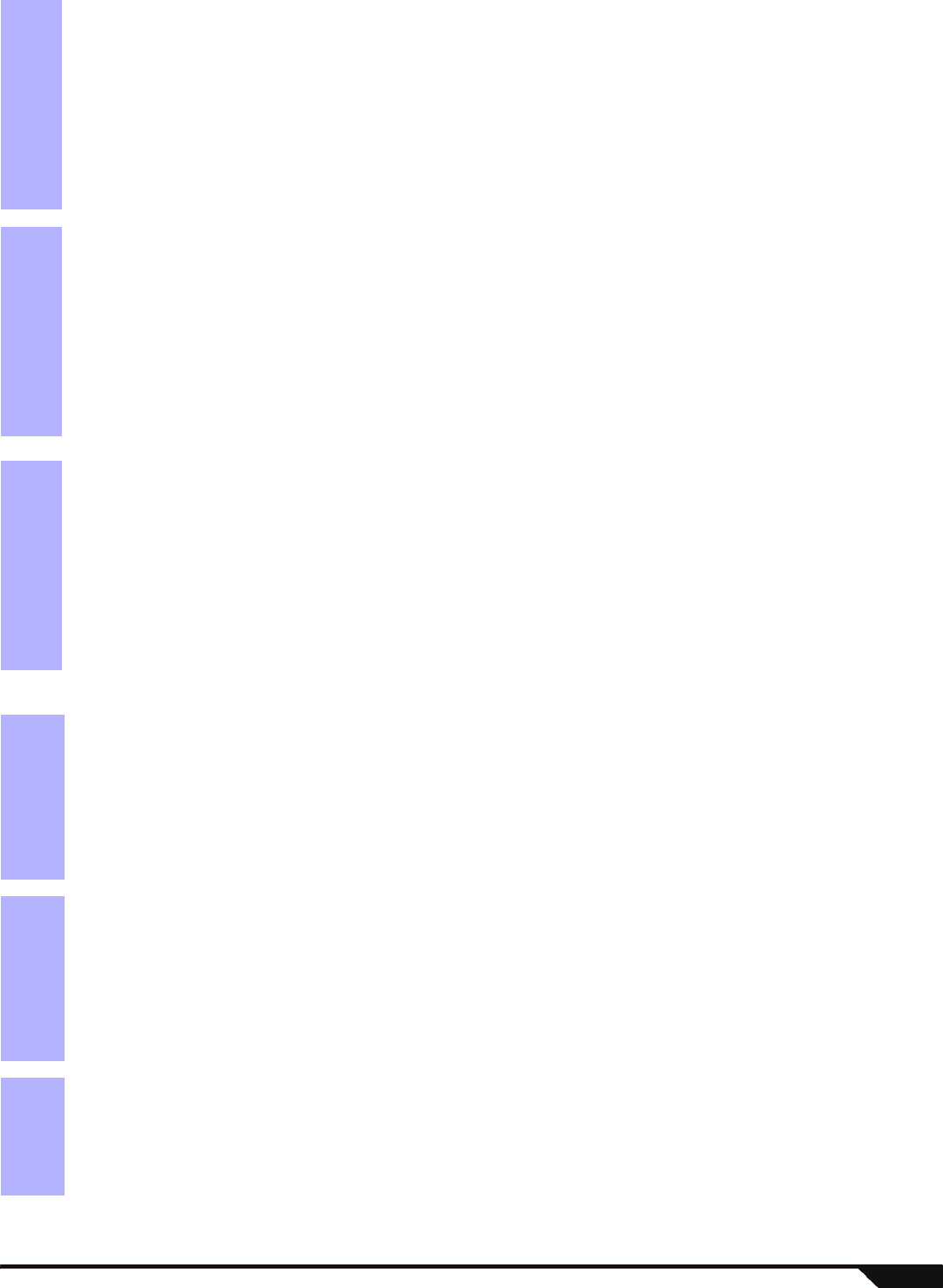
Magellan 15
* For UL installations, all programmed wireless zones must be supervised. For any wireless Fire zones in UL installations, the supervision option must be
enabled (section [094] options [6] & [7]) and the check-in supervision time must be set at 80 minutes (section [096] option [7]).
[291] Wireless Transmitter Supervision Zone Options * Bold = Default setting
Option OFF ON
[1] Zone 9 supervision Disabled Enabled
[2] Zone 10 supervision Disabled Enabled
[3] Zone 11 supervision Disabled Enabled
[4] Zone 12 supervision Disabled Enabled
[5] Zone 13 supervision Disabled Enabled
[6] Zone 14 supervision Disabled Enabled
[7] Zone 15 supervision Disabled Enabled
[8] Zone 16 supervision Disabled Enabled
[292] Wireless Transmitter Supervision Zone Options * Bold = Default setting
Option OFF ON
[1] Zone 17 supervision Disabled Enabled
[2] Zone 18 supervision Disabled Enabled
[3] Zone 19 supervision Disabled Enabled
[4] Zone 20 supervision Disabled Enabled
[5] Zone 21 supervision Disabled Enabled
[6] Zone 22 supervision Disabled Enabled
[7] Zone 23 supervision Disabled Enabled
[8] Zone 24 supervision Disabled Enabled
[293] Wireless Transmitter Supervision Zone Options * Bold = Default setting
Option OFF ON
[1] Zone 25 supervision Disabled Enabled
[2] Zone 26 supervision Disabled Enabled
[3] Zone 27 supervision Disabled Enabled
[4] Zone 28 supervision Disabled Enabled
[5] Zone 29 supervision Disabled Enabled
[6] Zone 30 supervision Disabled Enabled
[7] Zone 31 supervision Disabled Enabled
[8] Zone 32 supervision Disabled Enabled
[294] Wireless PGM Supervision Options Bold = Default setting
Option OFF ON
[1] Wireless PGM1 supervision Disabled Enabled
[2] Wireless PGM2 supervision Disabled Enabled
[3] Wireless PGM3 supervision Disabled Enabled
[4] Wireless PGM4 supervision Disabled Enabled
[5] to [8] Future Use
[295] Wireless Keypad Supervision Options Bold = Default setting
Option OFF ON
[1] Wireless Keypad 1 supervision Disabled Enabled
[2] Wireless Keypad 2 supervision Disabled Enabled
[3] Wireless Keypad 3 supervision Disabled Enabled
[4] Wireless Keypad 4 supervision Disabled Enabled
[5] to [8] Future Use
[296] Wireless Repeater Supervision Options Bold = Default setting
Option OFF ON
[1] Wireless Repeater 1 supervision Disabled Enabled
[2] Wireless Repeater 2 supervision Disabled Enabled
[3] to [8] Future Use

16 Programming Guide
Wireless Repeater Options
[297] Wireless PGM Console Supervision Options (Follow Alarm/Follow Bell) Bold = Default setting
Option OFF ON
[1] PGM1 console supervision Disabled Enabled
[2] PGM2 console supervision Disabled Enabled
[3] PGM3 console supervision Disabled Enabled
[4] PGM4 console supervision Disabled Enabled
[5] to [8] Future Use
Wireless Repeater Options Bold = Default setting MG-RPT1 #1
[300] MG-RPT1 #2
[306]
Option OFF ON OFF ON
[1] Repeat Wireless Zone 1 Signals N N
[2] Repeat Wireless Zone 2 Signals N N
[3] Repeat Wireless Zone 3 Signals N N
[4] Repeat Wireless Zone 4 Signals N N
[5] Repeat Wireless Zone 5 Signals N N
[6] Repeat Wireless Zone 6 Signals N N
[7] Repeat Wireless Zone 7 Signals N N
[8] Repeat Wireless Zone 8 Signals N N
Wireless Repeater Options Bold = Default setting MG-RPT1 #1
[301] MG-RPT1 #2
[307]
Option OFF ON OFF ON
[1] Repeat Wireless Zone 9 Signals N N
[2] Repeat Wireless Zone 10 Signals N N
[3] Repeat Wireless Zone 11 Signals N N
[4] Repeat Wireless Zone 12 Signals N N
[5] Repeat Wireless Zone 13 Signals N N
[6] Repeat Wireless Zone 14 Signals N N
[7] Repeat Wireless Zone 15 Signals N N
[8] Repeat Wireless Zone 16 Signals N N
Wireless Repeater Options Bold = Default setting MG-RPT1 #1
[302] MG-RPT1 #2
[308]
Option OFF ON OFF ON
[1] Repeat Wireless Zone 17 Signals N N
[2] Repeat Wireless Zone 18 Signals N N
[3] Repeat Wireless Zone 19 Signals N N
[4] Repeat Wireless Zone 20 Signals N N
[5] Repeat Wireless Zone 21 Signals N N
[6] Repeat Wireless Zone 22 Signals N N
[7] Repeat Wireless Zone 23 Signals N N
[8] Repeat Wireless Zone 24 Signals N N

Magellan 17
Wireless Repeater Options Bold = Default setting MG-RPT1 #1
[303] MG-RPT1 #2
[309]
Option OFF ON OFF ON
[1] Repeat Wireless Zone 25 Signals N N
[2] Repeat Wireless Zone 26 Signals N N
[3] Repeat Wireless Zone 27 Signals N N
[4] Repeat Wireless Zone 28 Signals N N
[5] Repeat Wireless Zone 29 Signals N N
[6] Repeat Wireless Zone 30 Signals N N
[7] Repeat Wireless Zone 31 Signals N N
[8] Repeat Wireless Zone 32 Signals N N
Wireless Repeater Options Bold = Default setting MG-RPT1 #1
[304] MG-RPT1 #2
[310]
Option OFF ON OFF ON
[1] Repeat Wireless 2-Way PGM 1 Signals N N
[2] Repeat Wireless 2-Way PGM 2 Signals N N
[3] Repeat Wireless 2-Way PGM 3 Signals N N
[4] Repeat Wireless 2-Way PGM 4 Signals N N
[5] to [8] Future Use N N
Wireless Repeater Options Bold = Default setting MG-RPT1 #1
[305] MG-RPT1 #2
[311]
Option OFF ON OFF ON
[1] Repeat Wireless Keypad 1 Signals N N
[2] Repeat Wireless Keypad 2 Signals N N
[3] Repeat Wireless Keypad 3 Signals N N
[4] Repeat Wireless Keypad 4 Signals N N
[5] Repeat Doorbell 1 Signals N N
[6] Repeat Doorbell 2 Signals N N
[7] & [8] Future Use N N

18 Programming Guide
Appendix 1: PGM Event Table
Event Group # Sub-group #
00 = Zone closed 01 to 32 = Zone number
99 = Any zone number
01 = Zone opened
02 = System status 00 = N/A
01 = N/A
02 = Silent alarm
03 = Buzzer alarm
04 = Steady alarm
05 = Pulsed alarm
06 = Strobe
07 = Siren stopped
08 = Squawk ON*
09 = Squawk OFF*
10 = Ground start
11 = System disarmed
12 = System armed
13 = Entry delay engaged
99 = Any system status event
03 = Bell status 00 = Bell OFF
01 = Bell ON
02 = Bell Squawk Arm
03 = Bell Squawk Disarm
04 = Future use Future use
05 = Non-reportable event 00 = Telephone line trouble
01 = Future use
02 = Arm with no entry delay
03 = Arm in Stay mode
04 = Arm in Force mode
05 = Full arm when armed in Stay mode
06 = PC fail to communicate
07 = Future use
08 = Future use
05 = Non-reportable event (cont.) 09 = Doorbell 1 battery trouble
10 = Doorbell 1 battery trouble restore
11 = Doorbell 2 battery trouble
12 = Doorbell 2 battery trouble restore
13 = Utility Key 1 pressed (keys [1] and [9] from the center keypad)
14 = Utility Key 2 pressed (keys [2] and [10] from the center keypad)
15 = Utility Key 3 pressed (keys [3] and [11] from the center keypad)
16 = Utility Key 4 pressed (keys [4] and [12] from the center keypad)
17 = Utility Key 5 pressed (keys [5] and [13] from the center keypad)
18 = Utility Key 6 pressed (keys [6] and [14] from the center keypad)
19 = Utility Key 7 pressed (keys [7] and [15] from the center keypad)
20 = Utility Key 8 pressed (keys [8] and [16] from the center keypad)
21 = User remote access granted (MG-6160 only)
22 = User remote access denied (MG-6160 only)
23 = Tamper generated alarm
24 = Supervision loss generated alarm
99 = Any non-reportable event
06 = Remote access 01 to 16 = User number
99 = Any user number
07 = PGM activation (Remote control button option “B”; see page 5)
08 = PGM activation (Remote control button option “C”; see page 5)
09 = Cold Start zone 01 to 32 = Zone number
99 = Any zone number
10 = Future use Future use
11 = Smoke Maintenance signal 01 to 32 = Zone number
99 = Any zone number
* Squawk ON/OFF is similar to Bell ON/OFF except it follows the arming/disarming even if section [093] option [3] is disabled (no
bell squawk when arming/disarming with remote control). These 2 events are used to activate/deactivate a light, strobe, or any
other PGM with squawk activation/deactivation capabilities.

Magellan 19
12 = Delay zone alarm transmission 01 to 32 = Zone number
99 = Any zone number
13 = Arming with user 01 to 32 = User number
99 = Any user number
14 = Special arming 00 = Auto-arming
01 = Late to close
02 = No movement arming
03 = Partial arming
04 = Quick arming
05 = Arming through WinLoad
99 = Any special arming event
15 = Disarming with user 01 to 16 = User number
99 = Any user number
16 = Disarm after alarm with user *
17 = Alarm cancelled with user **
18 = Special disarming 00 = Auto-arm cancelled
01 = Disarm through WinLoad
02 = Disarm through WinLoad after alarm *
03 = Alarm cancelled through WinLoad **
04 = Non-medical alarm cancelled
99 = Any special disarming event
19 = Zone bypassed
01 to 32 = Zone number
99 = Any zone number
20 = Zone in alarm
21 = Fire alarm
22 = Zone alarm restore
23 = Fire alarm restore
24 = Special alarm 00 = Panic non-medical emergency
01 = Panic medical (this medical panic alarm is not UL approved)
02 = Panic fire
03 = Recent closing
04 = Global shutdown
05 = Duress alarm (User 16)
99 = Any special alarm event
25 = Zone shutdown 01 to 32 = Zone number
99 = Any zone number
26 = Zone tampered
27 = Zone tamper restore
28 = New trouble 00 = N/A
01 = AC failure
02 = Battery failure
03 = Clock loss
04 = Console tamper
05 = Fail to communicate to monitoring station
06 = Fail to communicate to voice report
07 = Fail to communicate to pager
08 = RF jamming supervision
99 = Any new trouble event
29 = Trouble restored 00 = Telephone line restored
01 = AC failure
02 = Battery failure
03 = Clock lost
04 = Console tamper restore
05 = N/A
06 = N/A
07 = N/A
08 = RF jamming restore
99 = Any trouble restore event
30 = Low battery on zone
01 to 32 = Zone number
99 = Any zone number
31 = Low battery on zone restore
32 = Zone supervision trouble
33 = Zone supervision restored
* An armed system is or was in alarm and was disarmed by a user.
** A disarmed system is or was in alarm (e.g. 24Hr. zone) and was disarmed by a user.
Event Group # Sub-group #
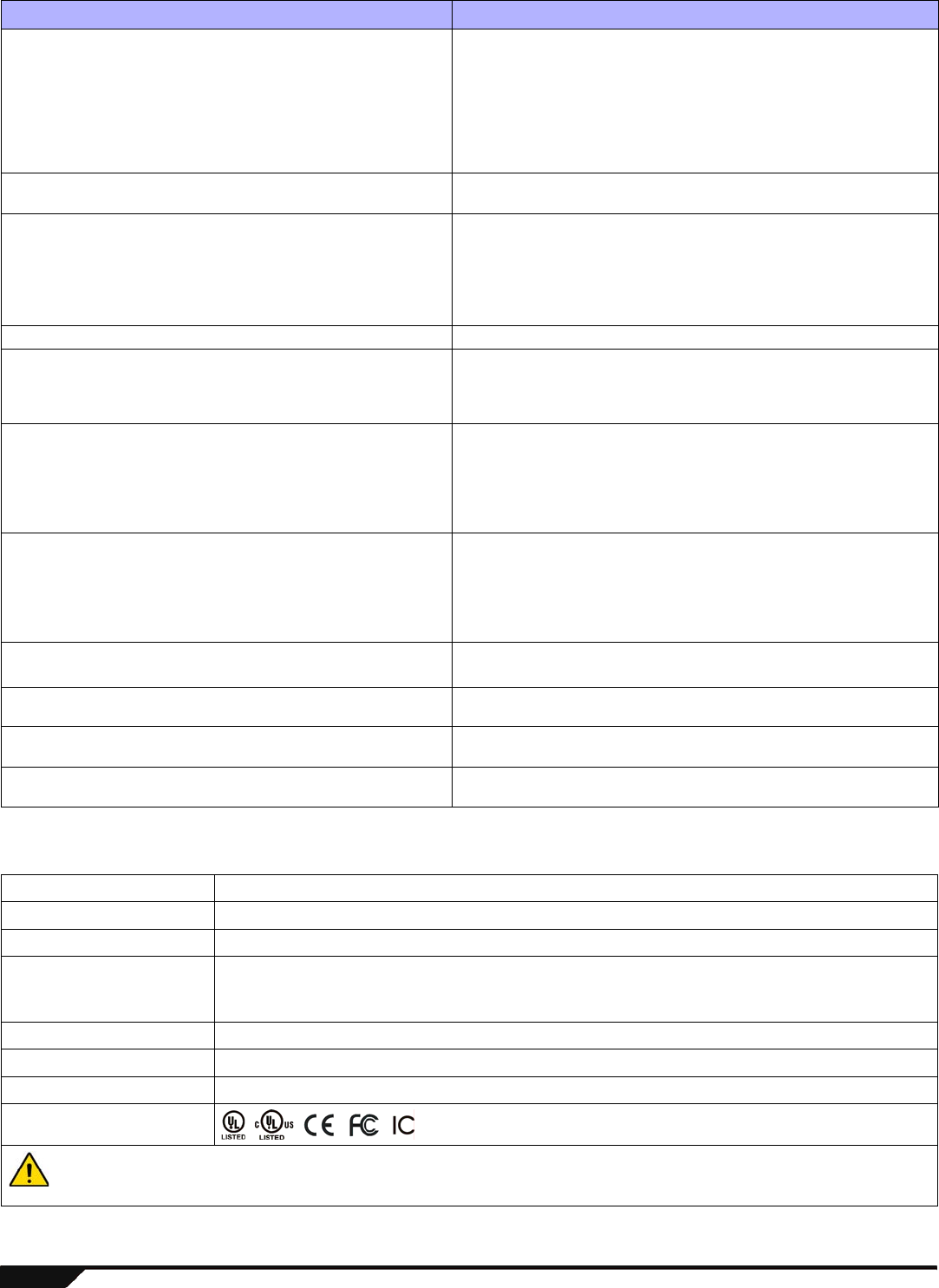
20 Programming Guide
Appendix 2: Specifications
34 = Special 00 = System power up
01 = Reporting test
02 = WinLoad logon
03 = WinLoad logoff
04 = Installer in programming mode
05 = Installer exited programming mode
06 = Closing delinquency delay elapsed
99 = Any special event
35 = Non-medical alarm 01 to 16 = User number
99 = Any user number
36 = Zone triggered a utility report
01 to 32 = Zone number
99 = Any zone number
37 = Signal strength weak 1
38 = Signal strength weak 2
39 = Signal strength weak 3
40 = Signal strength weak 4
41 & 42 = Reserved Reserved
43 = PGM supervision lost
44 = PGM supervision restored
45 = PGM tampered
46 = PGM tamper restored
01 to 04 = PGM number
99 = Any PGM number
47 = Wireless keypad supervision lost
48 = Wireless keypad supervision restored
49 = Wireless keypad battery trouble
50 = Wireless keypad battery trouble restored
51 = Wireless keypad AC failure
52 = Wireless keypad AC failure restored
01 to 04 = Keypad number
99 = Any keypad number
53 = Wireless repeater supervision lost
54 = Wireless repeater supervision restored
55 = Wireless repeater battery trouble
56 = Wireless repeater battery trouble restored
57 = Wireless repeater AC failure
58 = Wireless repeater AC failure restored
01 to 02 = Repeater number
99 = Any repeater number
80 = Fire delay started 01 to 32 = Zone number
99 = Any zone number
81= Fire delay cancelled
82 = PGM cold start 01 to 04 = PGM number
99 = Any PGM number
83 = Keypad cold start 01 to 04 = Keypad number
99 = Any keypad number
84 = Repeater cold start 01 to 02 = Repeater number
99 = Any repeater number
Input Voltage 12Vac to 16Vac* 20VA or 12Vdc to 18Vdc 1A
Max. Current Consumption 1A
Backup Battery 7.2Vdc NiMH rechargeable battery pack (order # 0780100178)
2 PGMs PGM1: N.O. solid-state relay (not polarized); Internal resistance 16 9(max.): Max. handling current
100mA
PGM2: One low powered open-collector; Max. handling current 50mA
Standby Battery Life Minimum 24 hours
Temperature Range 0°C to 50°C (32°F to 122°F)
Auxiliary Output When using an AC or DC power source, the auxiliary output provides 13.8V (200mA maximum)†
Approvals
* It is recommended that you use a 12Vac 1A transformer to power the Magellan console. The console will generate less heat when
connected to a 12Vac transformer than when connected to a 16.5Vac transformer.
† To achieve this value, use a minimum of 15Vdc.
Event Group # Sub-group #
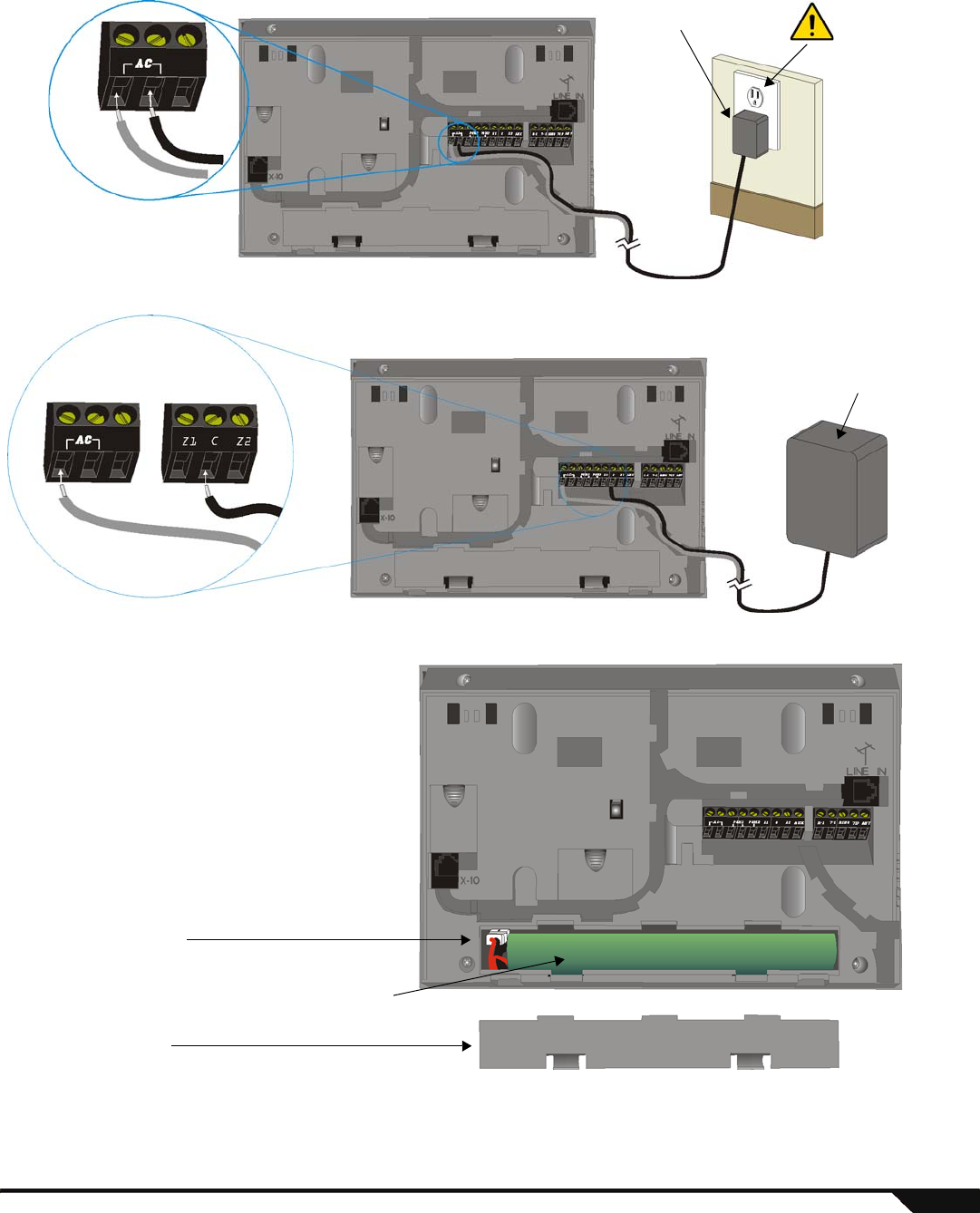
Magellan 21
Appendix 3: Connection Diagrams
Power Connections
Figure 2: Connecting the AC Transformer
Figure 3: Connecting the DC Power Supply
Figure 4: Connecting the Battery
Back view of the Magellan console. Do not use any switch-
controlled outlets.
12Vac to 16Vac 1A
Insert the transformer’s wires
into the AC terminals.
Back view of the Magellan console.
12Vdc to 18Vdc 1A
Insert the transformer’s wires into
the AC and COMMON terminals.
+
-
DC Power
Supply
Back view of the Magellan console.
Insert the backup battery’s plug into the
connector labelled BATT.
1.
Slide in the battery pack horizontally, tilt the battery pack
downward and then tuck it in Magellan’s battery compartment.
2.
3. Snap in the battery compartment
cover when finished.
To order a battery pack, the battery
pack’s part number is:
Paradox #0780100178.
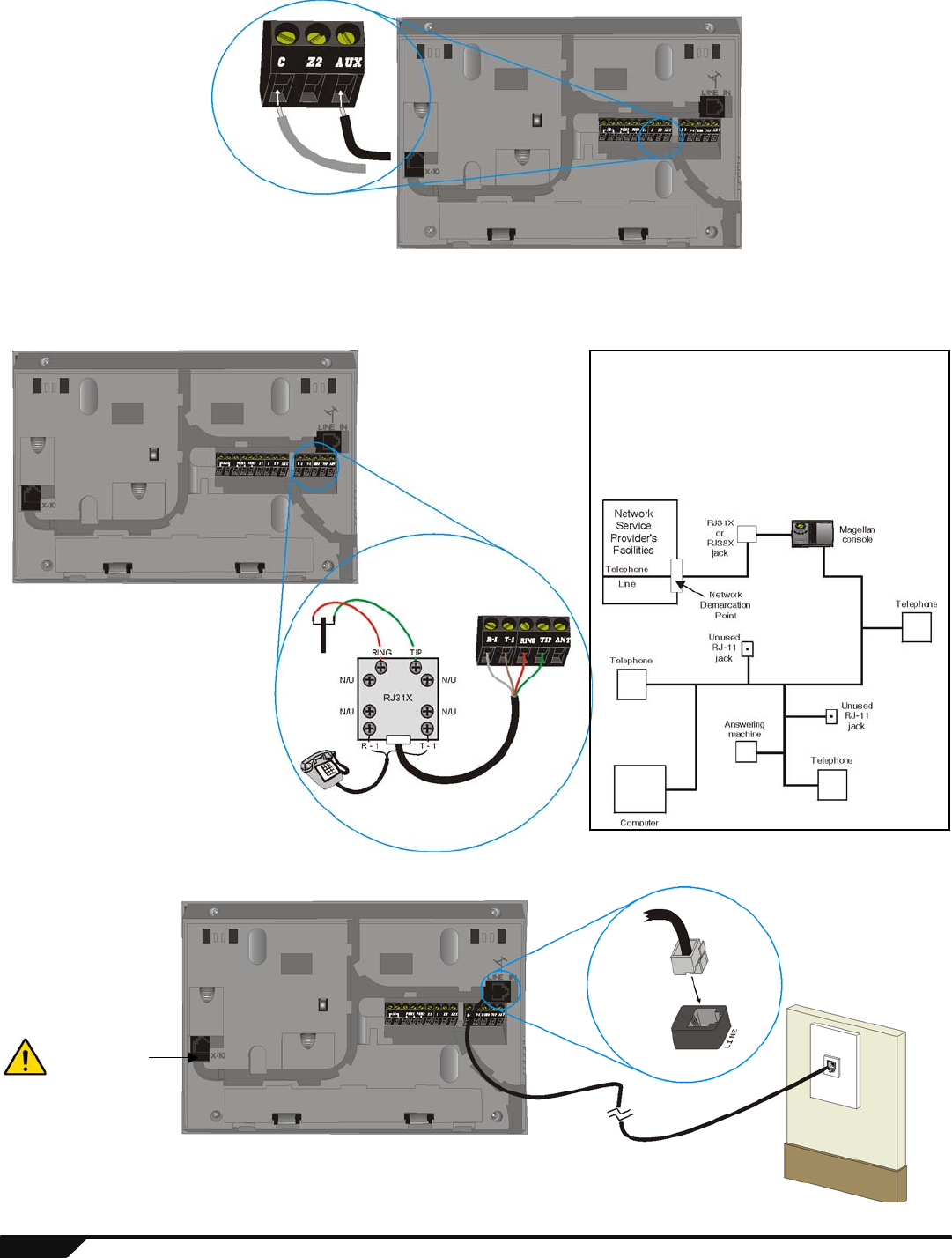
22 Programming Guide
Figure 5: Auxiliary Output
Telephone Line Connections
Figure 6: Telephone Line Direct Connect
Figure 7: Line Plug Connection
Back view of the Magellan console.
13.8Vdc, 200mA Auxiliary Output
+-
Back view of the Magellan console.
To connect the telephone line
directly to the console:
1. Connect a RJ31X to the R-1, T-
1, RING and TIP terminals as
shown at right.
2. Connect the telephone
company wires and the home
telephone to the RJ31X.
Telephone Line Connection Note
The Magellan console must be able to seize the telephone line and place a
call in an emergency situation. It must be able to do this even if other
equipment (telephones, answering machines, computer modems, etc.)
already has the line in use. To do so, the Magellan console must be
connected to a properly installed RJ31X (or RJ38X) jack that is electrically
in series with and ahead of all other equipment attached to the same
telephone line. Proper installation is depicted in the diagram below. If you
have any questions concerning these instructions, you should consult your
telephone company or a qualified installer about installing the RJ31X (or
RJ38X) jack and the Magellan console for you.
Back view of the
Magellan console.
To connect the telephone line directly to the console:
1. Insert one end of the 4-pin RJ-11 cable into the line plug of the Magellan console.
2. Insert the other end of the RJ-11 cable into a standard telephone wall plug.
Do not connect
the RJ-11 cable
into this plug.
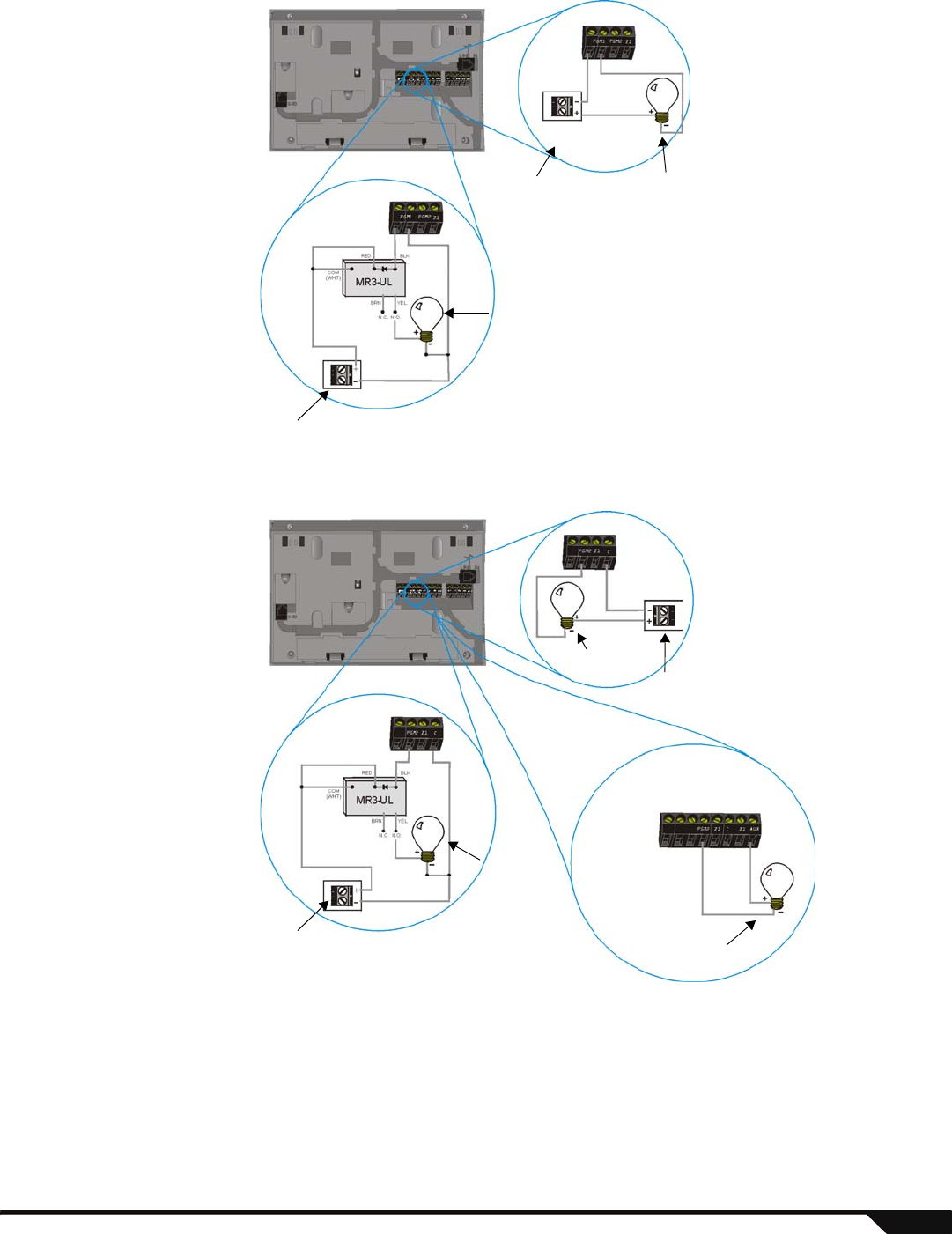
Magellan 23
PGM Connections
Figure 8: PGM1 Connections
Figure 9: PGM2 Connections
External DC
Power Supply
Devices
such as a
light, etc.
Devices
such as a
light, etc.
External DC
Power Supply
Method 1
(less than 100mA)
Method 2
(exceeds 100mA)
Back view of the Magellan console.
External
relay
External DC
Power Supply
Devices
such as a
light, etc.
Devices
such as a
light, etc.
External DC
Power Supply
Method 1
(less than 50mA)
Method 2
(exceeds 50mA)
Back view of the Magellan console.
External
relay
Method 3
(less than 50mA)
Devices
such as a
light, etc.
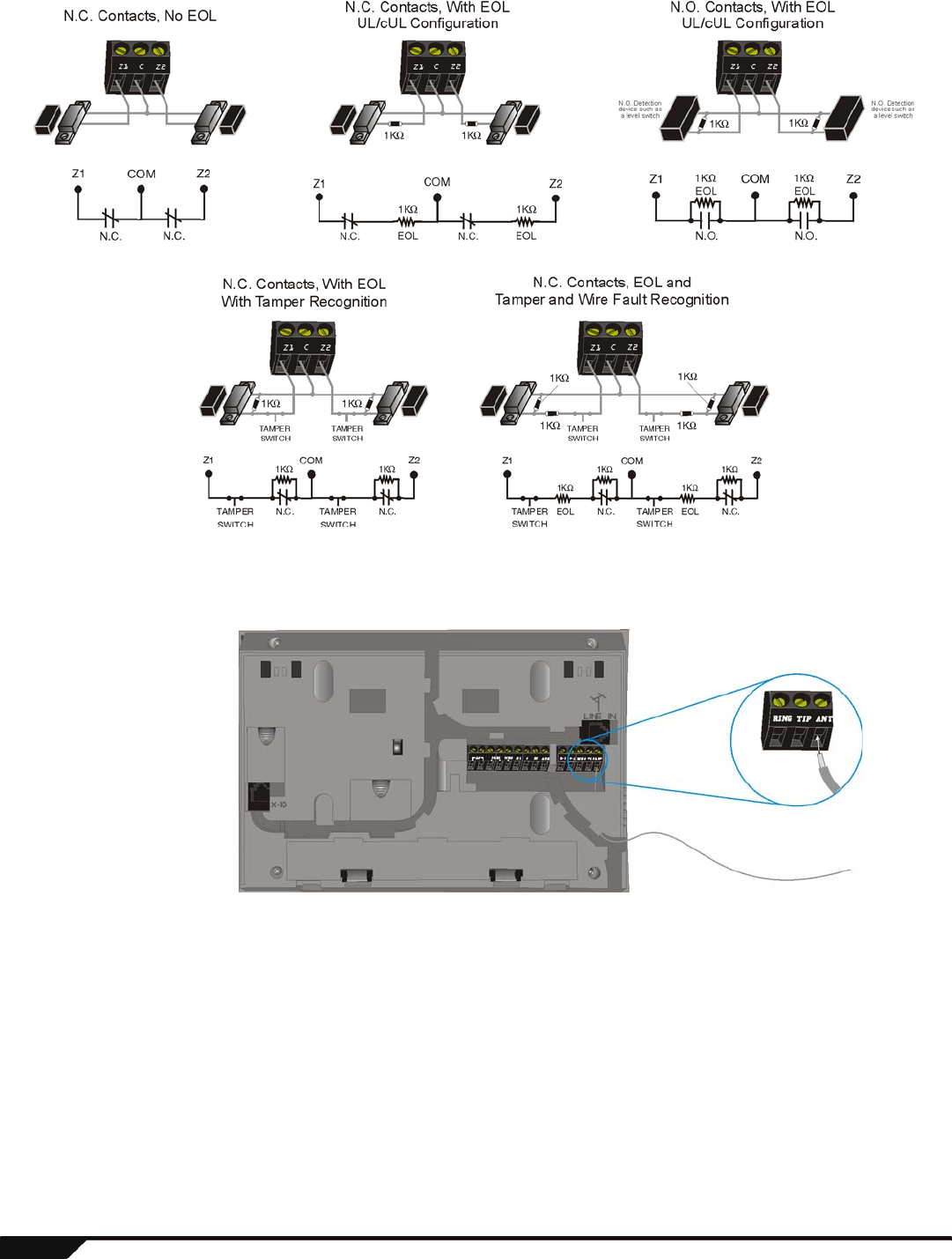
24 Programming Guide
Hardwire Zone Connections
Figure 10: Hardwire Zone Connections
Connecting the Radio Antenna (MG-6160 only)
Figure 11: Connecting the Radio Antenna
Back view of the
Magellan console.
If the radio reception is not very
good, connect the supplied radio
antenna to the ANT terminal of the
Magellan console. Move the
antenna around until the spot with
the best reception is found.
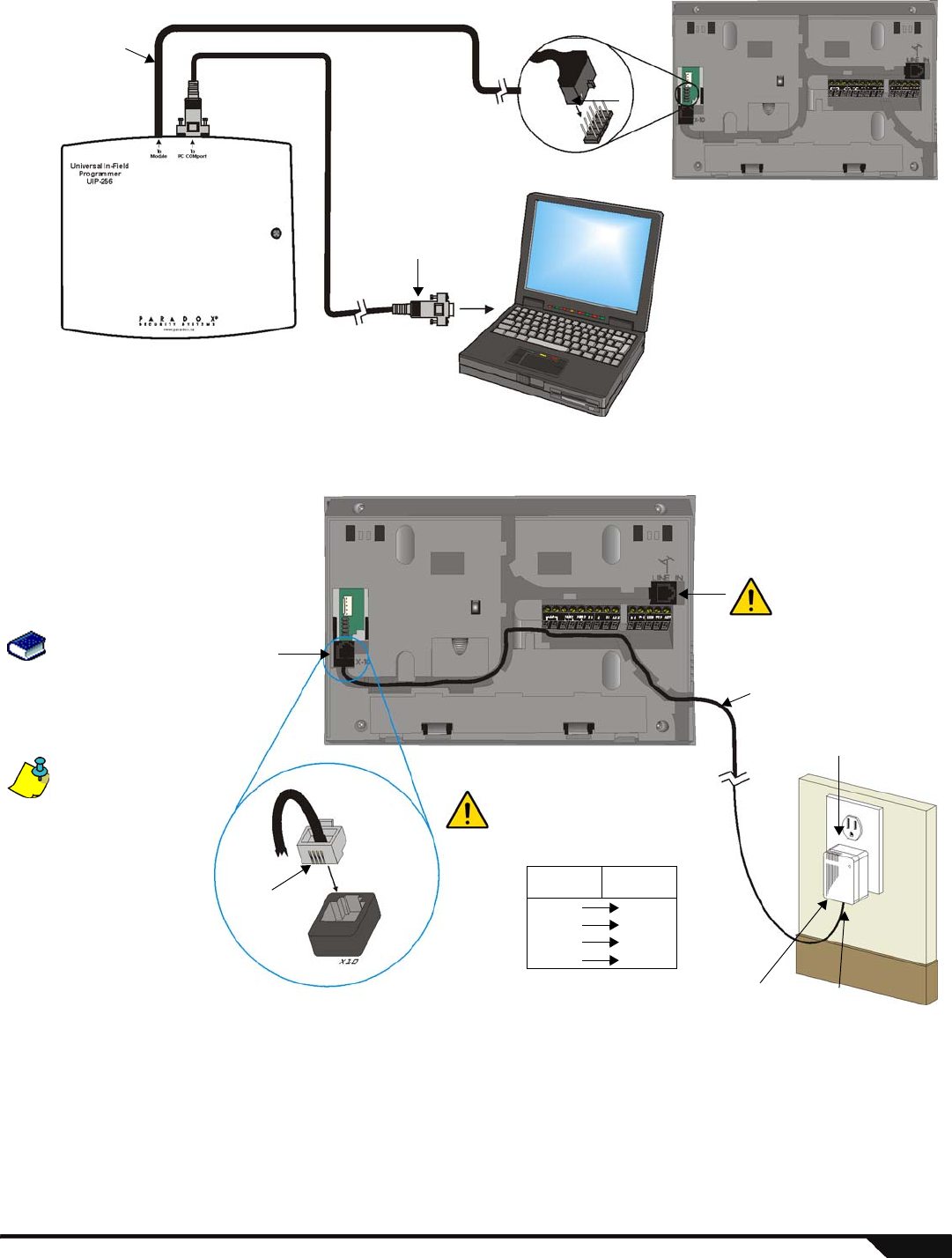
Magellan 25
Connecting to a UIP-256
Figure 12: Connecting to a UIP-256 Universal In-Field Programmer
X10 Transmitter Connections (MG-6160 only)
Figure 13: Connecting the X10 Transmitter
Back view of the
Magellan console.
Standard
DB-9 cable
(9-pin serial
cable)
Connect the 10-
pin cable of the
UIP-256 to the 10-
pin connector of
the Magellan
console
Download latest
firmware version of
Magellan from the
Paradox website at
paradox.com
UIP-256
Universal
In-Field
Programmer
Back view of the Magellan console.
Inverted
4-pin
RJ-11
cable
X10 transmitter
1. Connect one end of the inverted
4-pin RJ-11 cable into the X10
plug of the console.
2. Connect the other end of the
inverted 4-pin RJ-11 cable into the
X10 transmitter.
3. Plug the X10 transmitter into a
standard wall outlet.
1
2
3
Do not connect the X10
transmitter into this plug.
Inverted 4-pin
RJ-11 cable
For information on
programming the X10
features of Magellan, refer to
the X10 Operation User
Guide which can be found
and downloaded for free
from our Web site at
paradox.com.
Make sure that an inverted 4-pin
RJ-11 cable is used when
connecting the Magellan console to
the X10 transmitter. Note the pin
configuration below:
Magellan
Console X10
Transmitter
Pin 1 Pin 4
Pin 2 Pin 3
Pin 3 Pin 2
Pin 4 Pin 1
X10 devices (transmitters,
modules, etc.) are not
supplied and cannot be
purchased through Paradox
Security Systems Ltd.
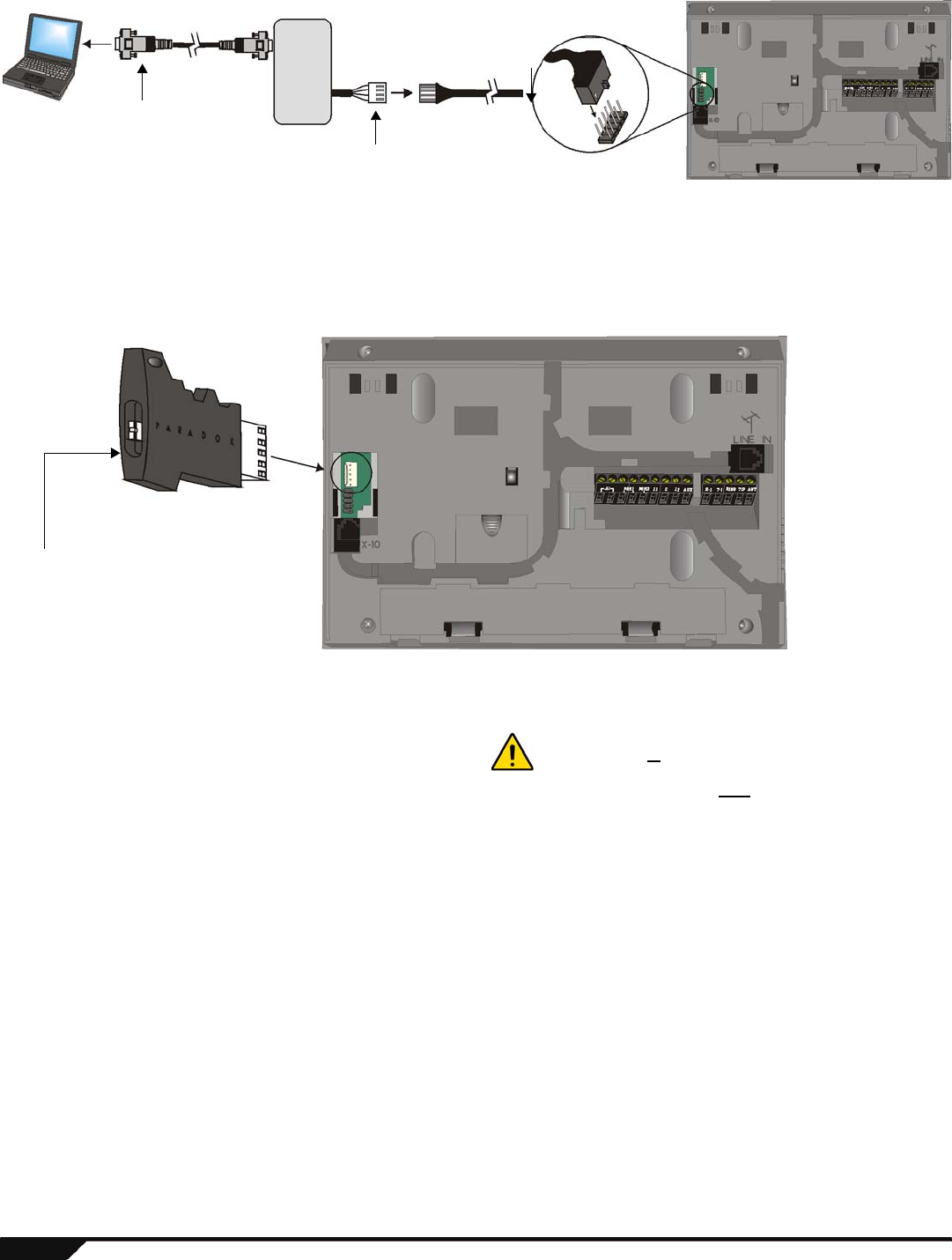
26 Programming Guide
Connecting Magellan to WinLoad
Figure 14: Connecting Magellan to WinLoad
Connecting a Paradox Memory Key (PMC-4)
Figure 15: Connecting a Paradox Memory Key (PMC-4)
Back view of the
Magellan console.
Computer
containing
WinLoad
software
4- to 10-pin cable
(supplied with the
306 Adapter)
306
Adapter
4-pin
connector
cable
Standard
DB-9 cable
(9-pin serial
cable)
Back view of the
Magellan console.
Jumper ON:
Read from and/or write to memory key
Jumper OFF:
Write protected (Read from the memory key
only)
PMC-4
Download Data to Destination Console
To download the data of a memory key into a console:
1. Remove power from the Magellan console (AC and battery) and
connect the memory key to the 5-pin connector on the left side of the
back of the console as shown above.
2. Re-apply both AC and battery power to the console.
3. Press the [OK] key and Magellan will begin downloading the data from
the memory key.
Copy Data to Memory Key from Source Console
To copy the contents of a console into the memory key.
1. Remove power from the Magellan console (AC and battery) and
connect the memory key to the 5-pin connector on the left side of the
back of the console as shown above. Re-apply both AC and battery
power to the console.
2. Press the [NEXT] key and then the [OK] key. Magellan will begin
copying its data into the memory key.
The installer code of the Magellan console used to
download data to the memory key must be the same
installer code programmed in the Magellan console that is
to download the contents from the same memory key. If the
installer codes do not match, the contents of the memory
key cannot be downloaded into the receiving console.
Example: The contents of the Magellan console A will be
copied into memory key B. The installer code for console A
is 111111. In order to download the contents of memory key
B into the Magellan console C, the installer code
programmed in console C must also be 111111.
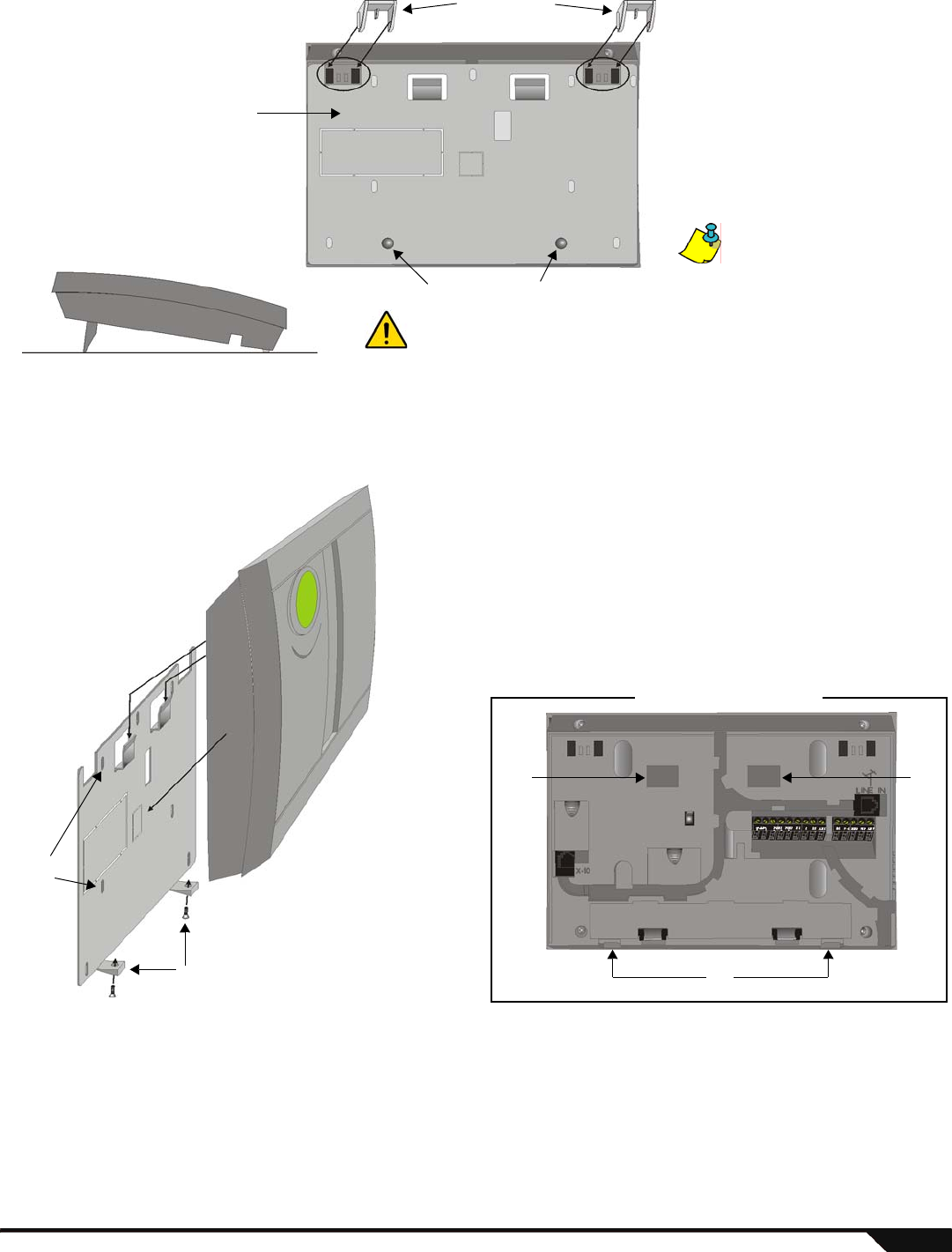
Magellan 27
Tabletop Mounting
Figure 16: Tabletop Mounting
Mounting Magellan on the Wall
Figure 17: Mounting Magellan onto the Wall Plate
To mount the Magellan console on a tabletop
the wall plate has to be inserted beforehand:
1. Slide the wall plate’s tabs labeled B into the
Magellan console’s open slots labeled D
(see Figure 17 on page 27).
2. Insert two screws (included) through the wall
plate’s screw holes labeled C into holes
labeled E in the Magellan console (see
Figure 17 on page 27).
3. Insert the two plastic feet (included) into the
appropriate holes on the back plate of the
Magellan console as shown at left.
4. Attach the two rubber stops (included) to the
lower edge of the wall plate as shown at left.
Wall plate
Plastic feet (x2)
Rubber stops (x2)
Tabletop
Back view of the
Magellan console.
The plastic feet are used to raise the
Magellan console to a slight angle for
easy viewing while the rubber stops
prevent the console from sliding when
Magellan is being used.
Tabletop mounting may not be an approved installation method by local regulations. It is
recommended that the local regulations be verified prior to installing the Magellan
console using this method.
C
B
To mount the Magellan console:
1. Place the console back plate flush against the mounted wall plate.
2. Slide the Magellan’s open slots labeled D (see Inset 1 below) onto the wall plate’s tabs labeled B.
3. Gently apply downward pressure to insert the wall plate’s tabs into Magellan’s open slots.
4. Insert two screws through the wall plate’s screw holes labeled C and into Magellan’s back plate
screw holes labeled E (see Inset 1 below). This will secure the console to the wall.
To mount the wall plate:
1. Place the wall plate on the desired spot of the wall.
2. Drill and insert the screws into the holes labeled A at left.
A (x7)
D D
E
Inset 1: Magellan’s Backplate
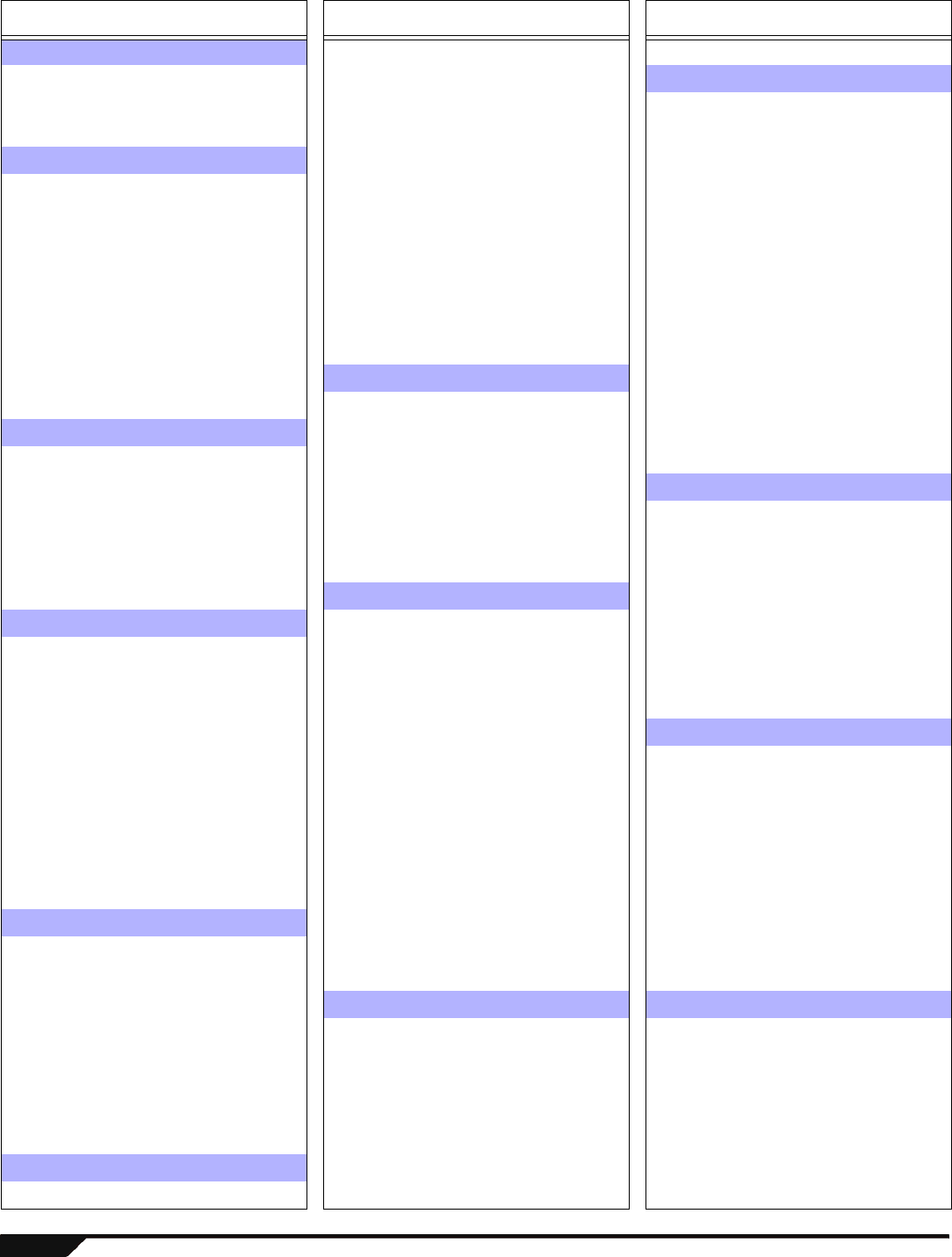
28 Programming Guide
Appendix 4: Ademco Contact ID Report Codes
CID# Reporting Code Programming
Value CID# Reporting Code Programming
Value CID# Reporting Code Programming
Value
Medical Alarms - 100 151 Gas detected 26 327 Notification appliance chk. #4 4E
100 Medical alarm * 01 152 Refrigeration 27 System Peripheral Troubles - 330 and 340
101 Pendant transmitter 02 153 Loss of heat 28 330 System peripheral 4F
102 Fail to report in 03 154 Water leakage 29 331 Polling loop open 50
Fire Alarms - 110 155 Foil break 2A 332 Polling loop short 51
110 Fire alarm 04 156 Day trouble 2B 333 Expansion module failure 52
111 Smoke 05 157 Low bottled gas level 2C 334 Repeater failure 53
112 Combustion 06 158 High temperature 2D 335 Local printer paper out 54
113 Water flow 07 159 Low temperature 2E 336 Local printer failure 55
114 Heat 08 161 Loss of air flow 2F 337 Exp. module DC loss 56
115 Pull station 09 162 Carbon monoxide detected 30 338 Exp. module low battery 57
116 Duct 0A 163 Tank level 31 339 Exp. module reset 58
117 Flame 0B Fire Supervisory - 200 and 210 341 Exp. module tamper 59
118 Near alarm 0C 200 Fire supervisory 32 342 Exp. module AC loss 5A
Panic Alarms - 120 201 Low water pressure 33 343 Exp. module self-test fail 5B
120 Panic Alarm 0D 202 Low CO234 344 RF receiver jam detect 5C
121 Duress 0E 203 Gate valve sensor 35 Communication Troubles - 350 and 360
122 Silent 0F 204 Low water level 36 350 Communication 5D
123 Audible 10 205 Pump activated 37 351 Telco 1 fault 5E
124 Duress - Access grated 206 Pump failure 38 352 Telco 2 fault 5F
125 Duress - Egress granted 12 System Troubles - 300 and 310 353 Long range radio 60
Burglar Alarms - 130 300 System trouble 39 354 Fail to communicate 61
130 Burglary 13 301 AC loss 3A 355 Loss of radio supervision 62
131 Perimeter 14 302 Low system battery 3B 356 Loss of central polling 63
132 Interior 15 303 RAM checksum bad 3C 357
Long range radio VSWR prob.
64
133 24-hour 16 304 ROM checksum 3D Protection Loop Troubles - 370
134 Entry/Exit 17 305 System reset 3E 370 Protection loop 65
135 Day/Night 18 306 Panel program changed 3F 371 Protection loop open 66
136 Outdoor 19 307 Self-test failure 40 372 Protection loop short 67
137 Tamper 1A 308 System shutdown 41 373 Fire trouble 68
138 Near alarm 1B 309 Battery test failure 42 374 Exit error alarm 69
139 Intrusion verified 1C 310 Ground fault 43 375 Panic zone trouble 6A
General Alarms - 140 311 Battery missing/dead 44 376 Hold-up zone trouble 6B
140 General alarm 1D 312 Power supply over current limit 45 377 Swinger trouble 6C
141 Polling loop open 1E 313 Engineer reset 46 378 Cross-zone trouble 6D
142 Polling loop short 1F Sounder/Relay Troubles - 320 Sensor Troubles - 380 and 390
143 Expansion module failure 20 320 Sounder/relay 47 380 Sensor trouble 6E
144 Sensor tamper 21 321 Bell 1 48 381 Loss of supervision - RF 6F
145 Expansion module tamper 22 322 Bell 2 49 382 Loss of supervision - RPM 70
146 Silent burglary 23 323 Alarm relay 4A 383 Sensor tamper 71
147 Sensor supervision failure 24 324 Trouble relay 4B 384 RF transmitter low battery 72
24-hour Non-burglary - 150 and 160 325 Reversing relay 4C 385 Smoke detector Hi sensitivity 73
150 24-hour non-burglary 25 326 Notification appliance chk. #3 4D 386 Smoke detector Low sensitivity 74
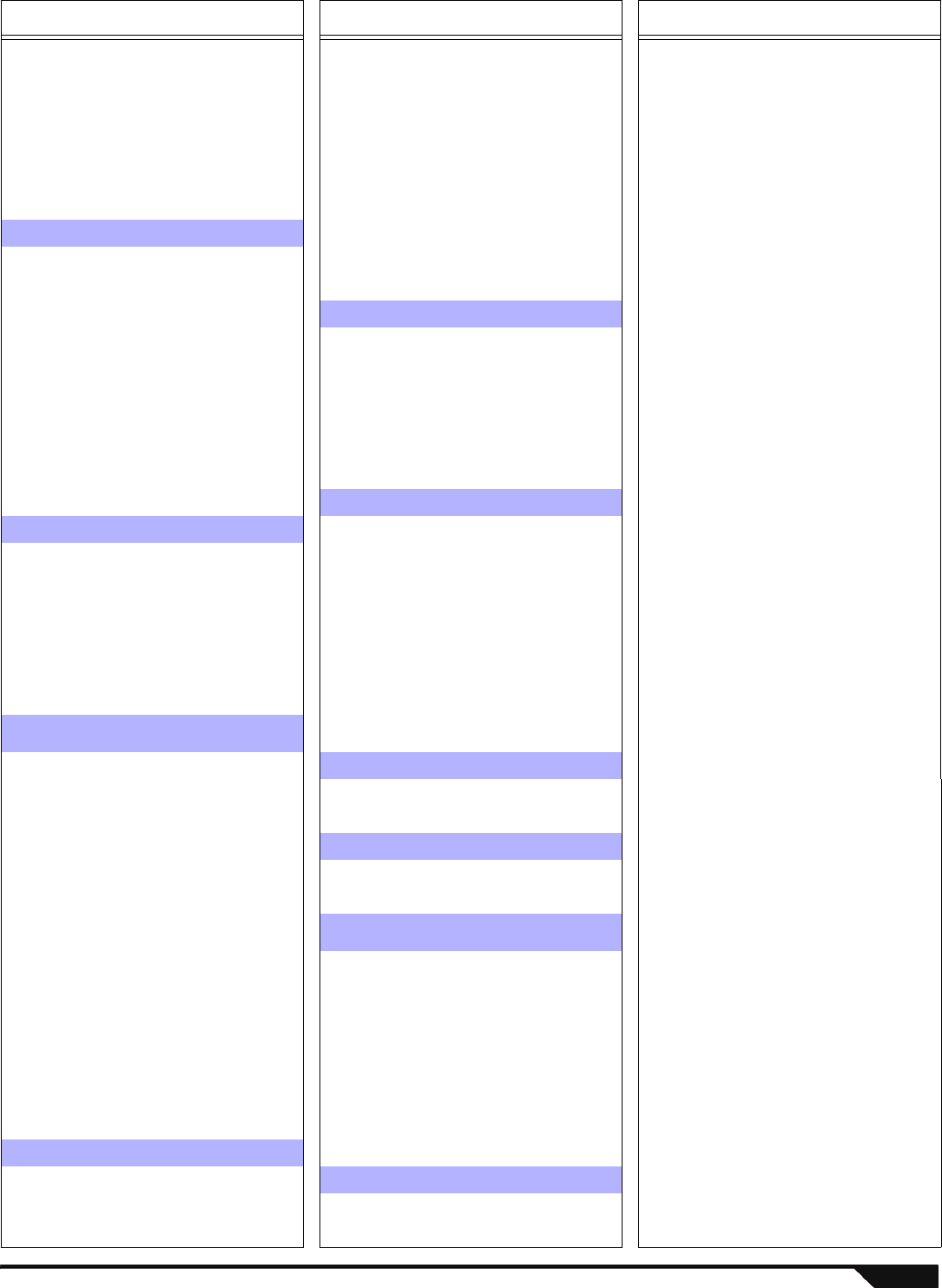
Magellan 29
387 Intrusion detector Hi sensitivity 75 451 Early open/close 9A 603 Periodic RF transmission BF
388 Intrusion detector Low
sensitivity 76 452 Late open/close 9B 604 Fire test C0
389 Sensor self-test failure 77 453 Failed to open 9C 605 Status report to follow C1
391 Sensor watch trouble 78 454 Failed to close 9D 606 Listen-in to follow C2
392 Drift compensation error 79 455 Auto-arm failed 9E 607 Walk test mode C3
393 Maintenance alert 7A 456 Partial arm 9F 608 Periodic test - system trouble
present C4
Open/Close - 400 457 Exit error (user) A0 609 Video transmitter active C5
400 Open/Close 7B 458 User on premises A1 611 Point test OK C6
401 Open/Close by user 7C 459 Recent close A2 612 Point not tested C7
402 Group open/close 7D System - 460 613 Intrusion zone walk tested C8
403 Automatic open/close 7E 461 Wrong code entry A3 614 Fire zone walk tested C9
404 Late to open/close 5E 462 Legal code entry A4 615 Panic zone walk tested CA
405 Deferred open/close 5F 463 Re-arm after alarm A5 616 Service request CB
406 Cancel 7F 464 Auto-arm time extended A6 621 Event log reset CC
407 Remote arm/disarm 80 465 Panic alarm reset A7 622 Event log 50% full CD
408 Quick arm 81 466 Service ON/OFF premises A8 623 Event log 90% full CE
409 Keyswitch open/close 82 Sounder Relay Disabled - 520 624 Event log overflow CF
Remote Access - 410 520 Sounder/Relay disabled A9 625 Time/Date reset D0
411 Call back request made 83 521 Bell 1 disabled AA 626 Time/Date inaccurate D1
412 Success - download access 84 522 Bell 2 disabled AB 627 Program mode entry D2
413 Unsuccessful access 85 523 Alarm relay disabled AC 628 Program mode exit D3
414 System shutdown 86 524 Trouble relay disabled AD 629 32-hour event log marker D4
415 Dialer shutdown 87 525 Reversing relay disabled AE 630 Schedule change D5
416 Successful upload 88 526 Notification appliance chk. #3
disabled AF 631 Exception schedule change D6
Access Control - 420 and 430 527 Notification appliance chk. #4
disabled B0 632 Access schedule change D7
421 Access denied 89 Modules - 530 654 System inactivity D8
422 Access report by user 8A 531 Module added B1
423 Forced access 8B 532 Module removed B2
424 Egress denied 8C Communication Disables - 550 and 560
425 Egress granted 8D 551 Dialer disabled B3
426 Access door propped open 8E 552 Radio transmitter disabled B4
427 Access point door status
monitor trouble 8F Bypasses - 570
428 Access point request to exit 90 570 Zone bypass B5
429 Access program mode entry 91 571 Fire bypass B6
430 Access program mode exit 92 572 24Hr. zone bypass B7
431 Access threat level change 93 573 Burglary bypass B8
432 Access relay/trigger fail 94 574 Group bypass B9
433 Access RTE shunt 95 575 Swinger bypass BA
434 Access DSM shunt 96 576 Access zone shunt BB
Arming - 440 and 450 577 Access point bypass BC
441 Armed Stay 97 Test/Misc. - 600
442 Keyswitch armed Stay 98 601 Manual trigger test BD
450 Exception open/close 99 602 Periodic test report BE
CID# Reporting Code Programming
Value CID# Reporting Code Programming
Value CID# Reporting Code Programming
Value

30 Programming Guide
Appendix 5: Automatic Report Code List
System Event Default Contact ID Report Code
when using sections [790] to [795] Default SIA Report Code
when using sections [790] to [795]
Arming with Master Code (##) 3 4A1 - Close by user CL - Closing Report
Arming with User Code (##) 3 4A1 - Close by user CL - Closing Report
Arming with Keyswitch (##) 3 4A9 - Keyswitch Close CS - Closing Keyswitch
Auto Arming 3 4A3 - Automatic Close CA - Automatic Closing
Arm with PC software 3 4A7 - Remote arm/disarm CL - Closing Report
Late To Close 3 4A4 - Late to Close OT - Late to Close
No Movement 3 4A4 - Late to Close NA - No Activity
Partial arming 1 574 - Group bypass CG - Close Area
Quick arming 3 408 - Quick arm CL - Closing Report
Closing Delinquency 1 654 - System Inactivity CD - System Inactivity
Disarm with Master Code (##) 1 4A1 - Open by user OP - Opening Report
Disarm with User Code (##) 1 4A1 - Open by user OP - Opening Report
Disarm with Keyswitch (##) 1 4A9 - Keyswitch Open OS - Opening Keyswitch
Disarm after alarm* with Master Code (##) 1 4A1 - Open by user OP - Opening Report
Disarm after alarm* with User Code (##) 1 4A1 - Open by user OP - Opening Report
Disarm after alarm* with Keyswitch (##) 1 4A1 - Keyswitch Open OS - Opening Keyswitch
Cancel alarm** with Master Code (##) 1 4A6 - Open by user OR - Disarm from Alarm
Cancel alarm** with User Code (##) 1 4A6 - Open by user OR - Disarm from Alarm
Cancel alarm** with Keyswitch (##) 1 4A6 - Keyswitch Open OS - Opening Keyswitch
Auto Arming Cancellation 1 4A5 - Deferred Open/Close CE - Closing Extend
Disarm with PC software 1 4A7 - Remote arm/disarm OP - Opening Report
Disarm after an alarm with PC software 1 4A7 - Remote arm/disarm OR - Disarm From Alarm
Quick disarm 1 408 - Quick disarm OP - Opening Report
Zone Bypassed (##) 1 57A - Zone bypass UB - Untyped Zone Bypass
Zone alarm (##) 1 13A - Burglary Alarm BA - Burglary Alarm
Fire alarm (##) 1 11A - Fire alarm FA - Fire Alarm
Zone alarm restore (##) 3 13A - Burglary Alarm Restore BH - Burglary Alarm Restore
Fire alarm restore (##) 3 11A - Fire alarm Restore FH - Fire Alarm Restore
Panic 1 - Emergency 1 12A - Panic alarm PA - Panic Alarm
Panic 2 - Medical 1 1AA - Medical alarm MA - Medical Alarm
Panic 3 - Fire 1 115 - Pull Station FA - Fire Alarm
Recent closing 3 4AA - Open/Close CR - Recent Closing
Global zone shutdown 1 574 - Group bypass CG - Close Area
Duress alarm 1 121 - Duress HA - Hold-up Alarm
Zone shutdown (##) 1 57A - Zone bypass UB - Untyped Zone Bypass
Zone tampered (##) 1 144 - Sensor tamper TA - Tamper Alarm
Zone tamper restore (##) 3 144 - Sensor tamper restore TR - Tamper Restoral
Keypad Lockout 1 421 - Access denied JA - User Code Tamper
* An armed system is or was in alarm and was disarmed by a user.
** A disarmed system is or was in alarm (e.g. 24Hr. zone) and was disarmed by a user.

Magellan 31
AC Failure 1 3A1 - AC loss AT - AC Trouble
Battery Failure 1 3A9 - Battery test failure YT - System Battery Trouble
Auxiliary supply trouble 1 3AA - System trouble YP - Power Supply Trouble
Bell output current limit 1 321 - Bell 1 YA - Bell Fault
Bell absent 1 321 - Bell 1 YA - Bell Fault
Clock lost 1 626 - Time/Date inaccurate JT - Time Changed
Fire loop trouble 1 373 - Fire trouble FT - Fire Trouble
TLM trouble restore 3 351 - Telco 1 fault restore LR - Phone Line restoral
AC Failure restore 3 3A1 - AC loss restore AR - AC Restoral
Battery Failure restore 3 3A9 - Battery test restore YR - System Battery Restoral
Auxiliary supply trouble restore 3 3AA - System trouble restore YQ - Power Supply restored
Bell output current limit restore 3 321 - Bell 1 restore YH - Bell Restored
Bell absent restore 3 321 - Bell 1 restore YH - Bell Restored
Clock programmed 3 625 - Time/Date Reset JT - Time Changed
Fire loop trouble restore 3 373 - Fire trouble restore FJ - Fire Trouble Restore
Combus fault 1 333 - Expansion module failure ET - Expansion Trouble
Module tamper 1 145 - Expansion module tamper TA - Tamper Alarm
Module ROM_RAM_error 1 3A4 - Rom checksum bad YF - Parameter Checksum Fail
Module TLM trouble 1 352 - Telco 2 fault LT - Phone Line trouble
Module fail to communicate to monitoring station. 1 354 - Fail to communicate YC - Communication Fails
Printer fault 1 336 - Local printer failure VT - Printer Trouble
Module AC Failure 1 3A1 - AC loss AT - AC Trouble
Module battery failure 1 3A9 - Battery test failure YT - System Battery Trouble
Module Auxiliary supply trouble 1 3AA - System trouble YP - Power Supply Trouble
Bus fault restore 3 333 - Expansion module failure restore ER - Expansion Restoral
Module tamper restore 3 145 - Expansion module tamper restore TR - Tamper Restoral
Module ROM_RAM_error restore 3 3A4 - Rom checksum bad restore YG - Parameter Changed
Module TLM restore 3 352 - Telco 2 fault restore LR - Phone Line Restoral
Printer fault restore 3 336 - Local printer failure restore VR - Printer Restore
Module AC restore 3 3A1 - AC loss restore AR - AC Restoral
Module battery restore 3 3A9 - Battery test failure restore YR - System Battery Restoral
Module Auxiliary supply restore 3 3AA - System trouble restore YQ - Power Supply Restored
Fail to communicate with monitoring station 1 354 - Fail to communicate YC - Communication Fails
Module RF low battery 1 384 - RF transmitter low battery XT - Transmitter Battery Trouble
Module RF battery restore 3 384 - RF transmitter battery restore XR - Transmitter Battery Restoral
Module RF supervision trouble 1 381 - Loss of supervision - RF US - Untype Zone Supervision
Module RF supervision restore 3 381 - Supervision restore - RF UR - Untyped Zone Restoral
Cold Start 1 3A8 - System shutdown RR - Power Up
Warm Start 1 3A5 - System reset YW - Watchdog Reset
Test Report engaged 1 6A2 - Periodic test report TX - Test Report
PC software communication finished 1 412 - Successful - download access RS - Remote Program Success
Installer on site 1 627 - Program mode Entry LB - Local Program
Installer programming finished 1 628 - Program mode Exit LS - Local Program Success
System Event Default Contact ID Report Code
when using sections [790] to [795] Default SIA Report Code
when using sections [790] to [795]

32 Programming Guide
Warranty
Paradox Security Systems Ltd. (“Seller”) warrants its products to be free from defects in materials and workmanship under normal use for a period of one year. Except as specifically stated herein, all express or
implied warranties whatsoever, statutory or otherwise, including without limitation, any implied warranty of merchantability and fitness for a particular purpose, are expressly excluded. Because Seller does not
install or connect the products and because the products may be used in conjunction with products not manufactured by Seller, Seller cannot guarantee the performance of the security system and shall not be
responsible for circumstances resulting from the product’s inability to operate. Seller obligation and liability under this warranty is expressly limited to repairing or replacing, at Seller's option, any product not
meeting the specifications. Returns must include proof of purchase and be within the warranty period. In no event shall the Seller be liable to the buyer or any other person for any loss or damages whether direct
or indirect or consequential or incidental, including without limitation, any damages for lost profits stolen goods, or claims by any other party, caused by defective goods or otherwise arising from the improper,
incorrect or otherwise faulty installation or use of the merchandise sold.
Notwithstanding the preceding paragraph, the Seller’s maximum liability will be strictly limited to the purchase price of the defective product. Your use of this product signifies your acceptance of this warranty.
BEWARE: Dealers, installers and/or others selling the product are not authorized to modify this warranty or make additional warranties that are binding on the Seller.
Limitations of Alarm Systems
It must be understood that while your Paradox alarm system is highly advanced and secure, it does not offer any guaranteed protection against burglary, fire or other emergency (fire and emergency options are
only available on certain Paradox models). This is due to a number of reasons, including by not limited to inadequate or improper installation/positioning, sensor limitations, battery performance, wireless signal
interruption, inadequate maintenance or the potential for the system or telephone lines to be compromised or circumvented. As a result, Paradox does not represent that the alarm system will prevent personal
injury or property damage, or in all cases provide adequate warning or protection.
Your security system should therefore be considered as one of many tools available to reduce risk and/or damage of burglary, fire or other emergencies, such other tools include but are not limited to insurance
coverage, fire prevention and extinguish devices, and sprinkler systems.
We also strongly recommend that you regularly maintain your security systems and stay aware of new and improved Paradox products and developments.
Warning for Connections to Non-Traditional Telephony (e.g. VoIP)
Paradox alarm equipment was designed to work effectively around traditional telephone systems. For those customers who are using a Paradox alarm panel connected to a non-traditional telephone system,
such as "Voice Over Internet Protocol" (VoIP) that converts the voice signal from your telephone to a digital signal traveling over the Internet, you should be aware that your alarm system may not function as
effectively as with traditional telephone systems.
For example, if your VoIP equipment has no battery back-up, during a power failure your system's ability to transmit signals to the central station may be compromised. Or, if your VoIP connection becomes
disabled, your telephone line monitoring feature may also be compromised. Other concerns would include, without limitation, Internet connection failures which may be more frequent than regular telephone line
outages.
We therefore strongly recommend that you discuss these and other limitations involved with operating an alarm system on a VoIP or other non-traditional telephone system with your installation company. They
should be able to offer or recommend measures to reduce the risks involved and give you a better understanding.
TBR-21
In order to comply with TBR-21, standard force dialing must be enabled.
UL AND ULC WARNINGS
UL AND C-UL INSTALLATION NOTES
This equipment is UL listed in accordance with standard UL1023 (Household Burglar -- Alarm Systems Units), standard UL985 (Household Fire Warning Units) and standard UL1635 (Digital Alarm
Communicator System Units). This equipment has the capability of being programmed with features not verified for use in UL installations. To stay within these standards, the installer should use the
following guidelines when configuring the system:
• All components of the system should be UL listed for the intended application.
• If the system will be used for “Fire” detection, the installer should refer to NFPA Standards #72, Chapter 2. In addition, once installation is complete, the local fire authority must be notified of the
installation.
• This equipment must be verified by a qualified technician once every three years.
• All keypads must use an anti-tamper switch.
• Maximum allowed entry delay is 45 seconds.
• Maximum allowed exit delay is 60 seconds.
• Minimum 4 minutes for bell cut-off time.
• The following features do not comply with UL requirements: Bypass Recall and Auto Trouble Shutdown.
• Do not connect the primary indicating device to a relay. The installer must use the bell output.
• To comply with UL985, the auxiliary power output should not exceed 200mA.
• Do not connect the zone ground terminal with UL Listed products.
• The metallic enclosure must be grounded to the cold water pipe.
• All outputs are Class 2 or power-limited, except for the battery terminal.The Class 2 and power-limited fire alarm circuits shall be installed using CL3, CL3R, CL3P, or substitute cable permitted by the
National Electrical Code, ANSI/NFPA 70.
RECOMMENDED:
• EOL resistor part #2011002000
•For UL Installations: Universal UB1640W 16.5VAC min 40VA
• All outputs are rated from 11.3Vdc to 12.7Vdc
• 12Vdc 4Ah rechargeable acid/lead or gel cell backup battery (YUASA model #NP7-12 recommended) for residential use. Use a 7Ah battery to comply with fire requirements.
• Wheelock 46T-12 siren
Legal
© 2004-2006 Paradox Security Systems Ltd. All rights reserved. Specifications may change without prior notice. One or more of the following US patents may apply: 6215399, 6111256, 5751803, 5721542,
5287111, 5119069, 5077549, 5920259, 5886632. Canadian and international patents may also apply. Magellan is a trademark or registered trademark of Paradox Security Systems Ltd. or its affiliates in
Canada, the United States and/or other countries.

NOTES

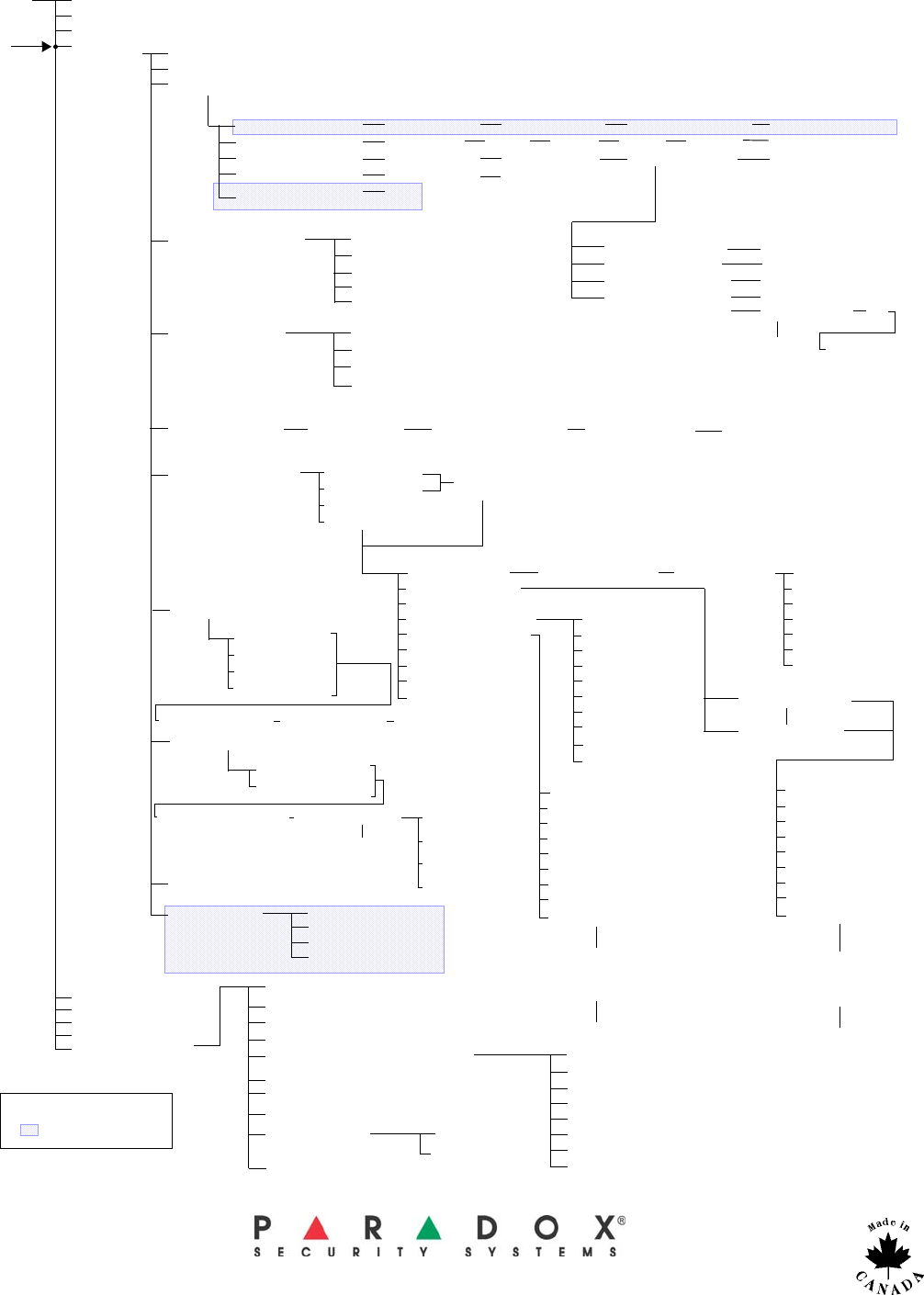
Installer Menu Overview
add tel. # 1
add tel.#1
add tel. # 1
1-bypass zones
2-alarm clock
3-time and date
4-system
setup
ready to
arm menu
1-language
2-user profile†
3-communicator
central report?
voice report?
utility report?
report format
record alrm mes?
record alrm mes?
type: disarming
type: trouble
type: paramedic
type: zone acti.
type: PANIC
select user
select trouble
select user
select zone
All panics?
4-delays & tones
pager report?
add service tel?
(MG-6160 only)
add tel. # 1
tel.:
add message?
entry delay 1?
entry delay 2?
exit delay?
bell cutoff del?
bell squawk?
5-system test test zones?
test remotes?
test reporting?
test hardware?
6-zone profile select zone open/close cover modify label? zone type
11-passwords installer code
maintenance code
panel id
pc password
10-signal strEngth
5-chime zone
6-alarm memory
7-history log
8-utility setup
9-version number
1-radio on arm (MG-6160 only)
2-auto arming
3-auto arm time
4-lost remote
5-x10 setup (MG-6160 only)
6-backlight adj.
7-contrast adj.
8-Brightness adj.
ring volume?
ring tone?
9-Ring Set-up
(MG6160 only)
10-demo mode
on time?
on zone open?
remote button?
on exit delay?
when armed?
on entry delay?
on alarm?
house code?
Must enter the
installer, maintenance
or user code to
access
= Master Code only
= Installer Code only
†
7-output profile add output1?
add output2?
add output3?
add output4?
wireless
output?
modify label?
remote access?
follow bell?
alarm activation
zone activation?
follow arm?
follow stay arm?
console superv?
custom setup?
delete output? modify label? follow bell?
alarm activation
zone activation?
follow arm?
follow stay arm?
console superv?
custom setup?
follow alarm?
pulse on alarm?
on for 1 sec?
on for 5 sec?
on for 15 sec?
on for 30 sec?
on for 1 min?
on for 5 min?
on for 15 min?
on for 30 min?
follow zone?
on for 1 sec?
on for 5 sec?
on for 15 sec?
on for 30 sec?
on for 1 min?
on for 5 min?
on for 15 min?
on for 30 min?
toggle on/off?
on for 1 sec?
on for 5 sec?
on for 15 sec?
on for 30 sec?
on for 1 min?
on for 5 min?
on for 15 min?
on for 30 min?
another output?
modify button?
press button
on all remotes?
master? yes
user XX? Yes
another output?
on all zones?
master? yes
user XX? Yes
yes
no
select TYPE:
EMERGENCY
AUXILIARY
FIRE
DURESS
yes
no
add tel. # 1 account number
report type?
add backup #
add tel. # 2
TEL#2 TEL#3 TEL#4 TEL.#5
8-keypad profile
9-repeater profile
add KEYPAD1?
add KEYPAD2?
add KEYPAD3?
add KEYPAD4?
add REPEATER1?
add REPEATER2?
select zone?
DELETE KEYPAD? modify label? aNOTHER KEYPAD?
select output?
select KEYPAD?
save profile?
DELETE Repeater? modify label?
yes
no
paradox.com
PRINTED IN CANADA - 12/2006 MAGELLAN-EP06